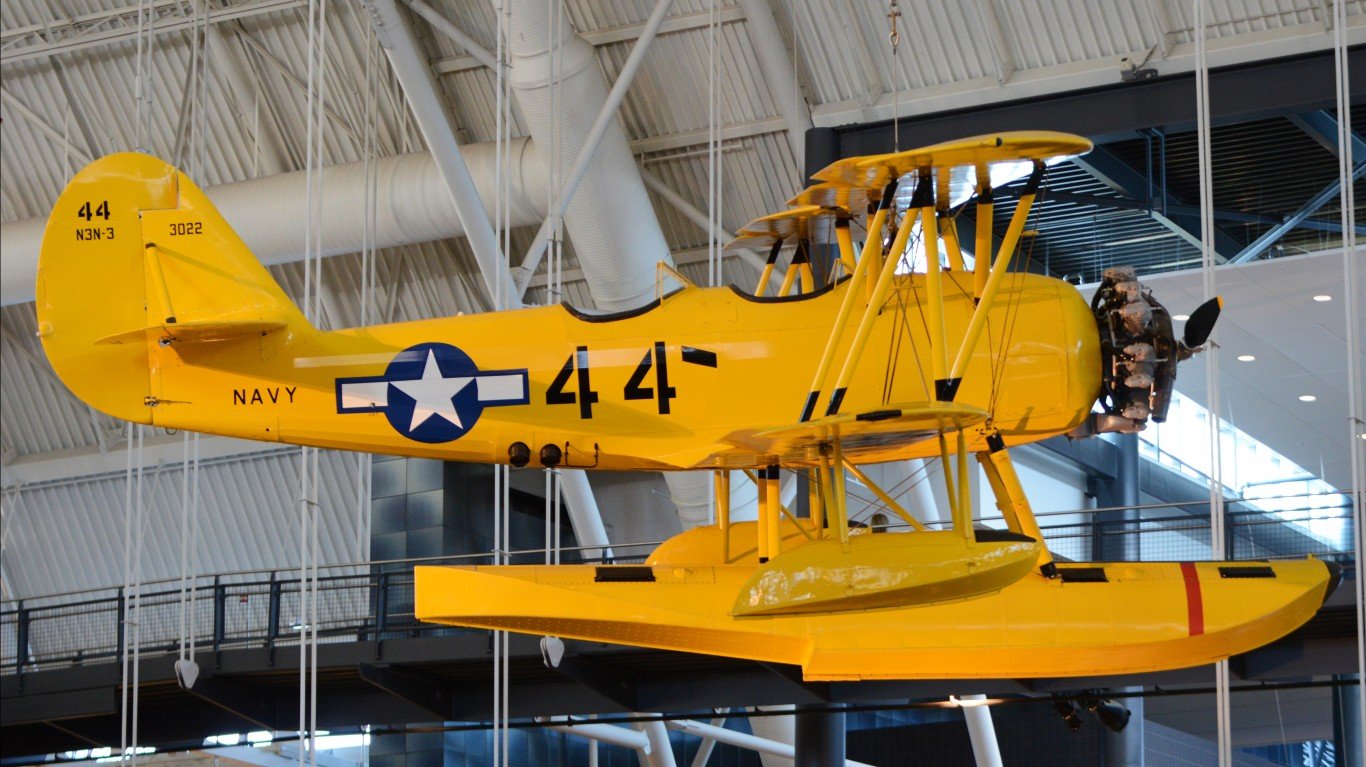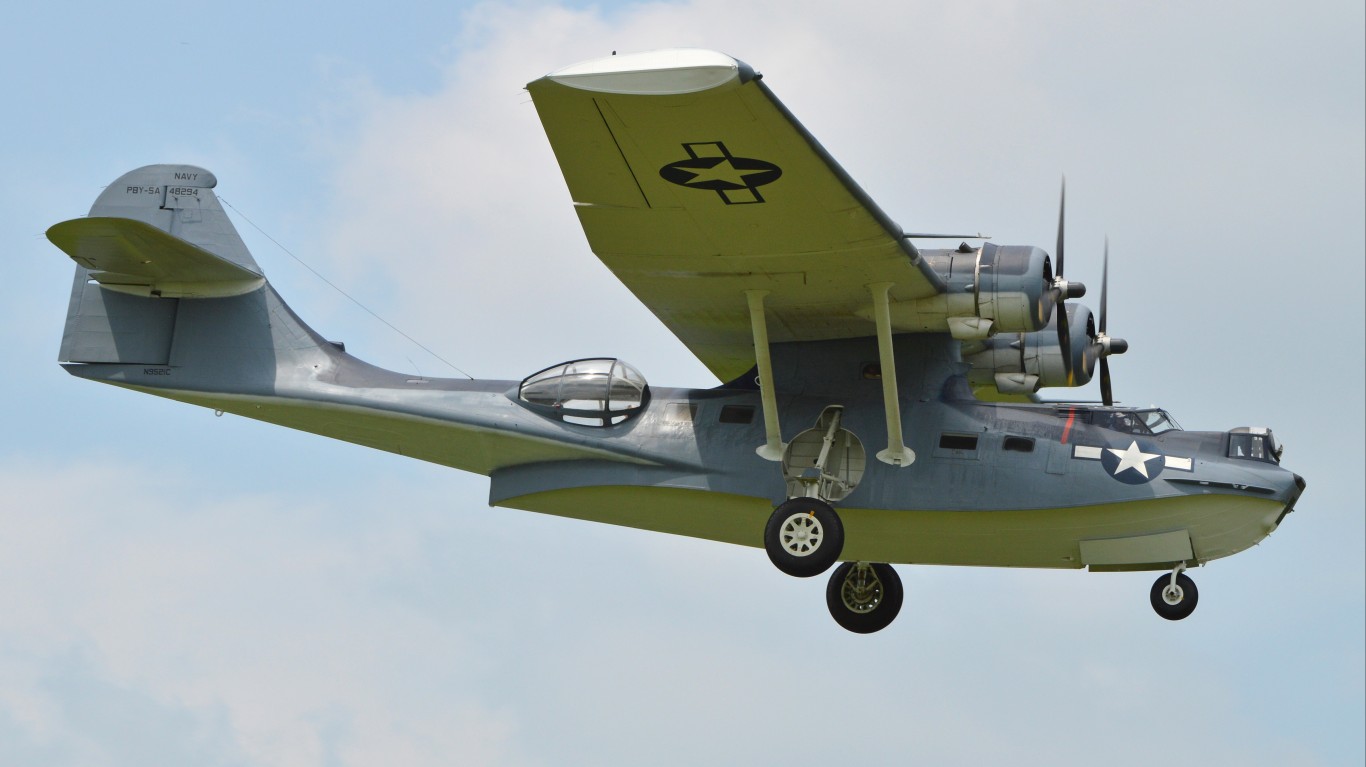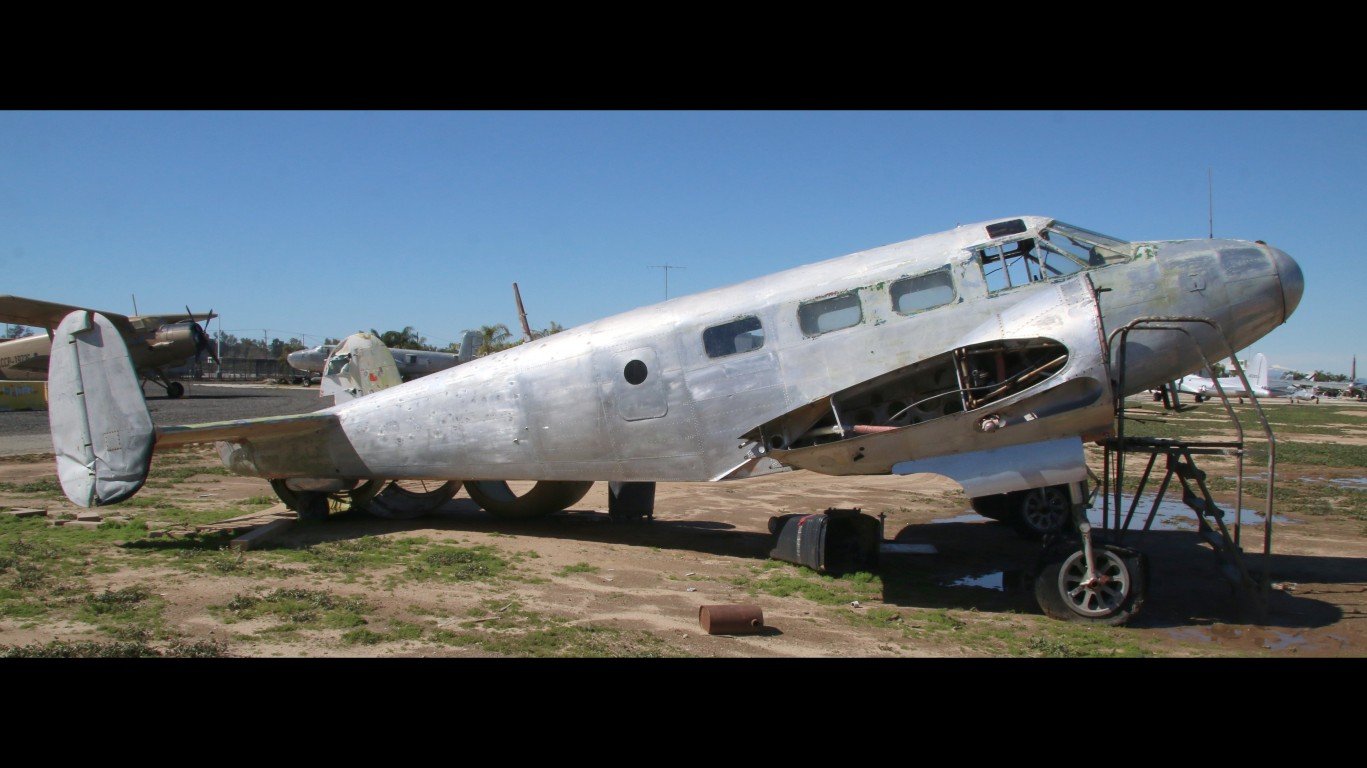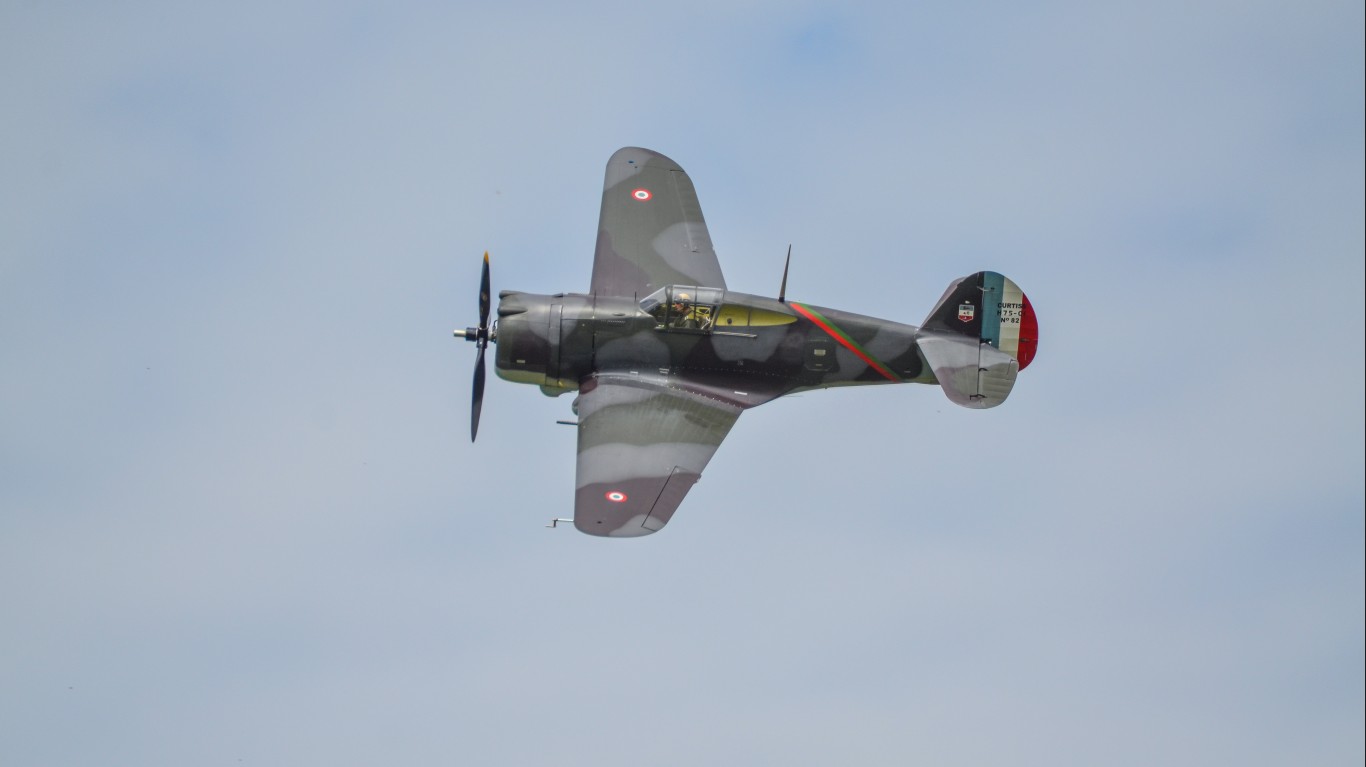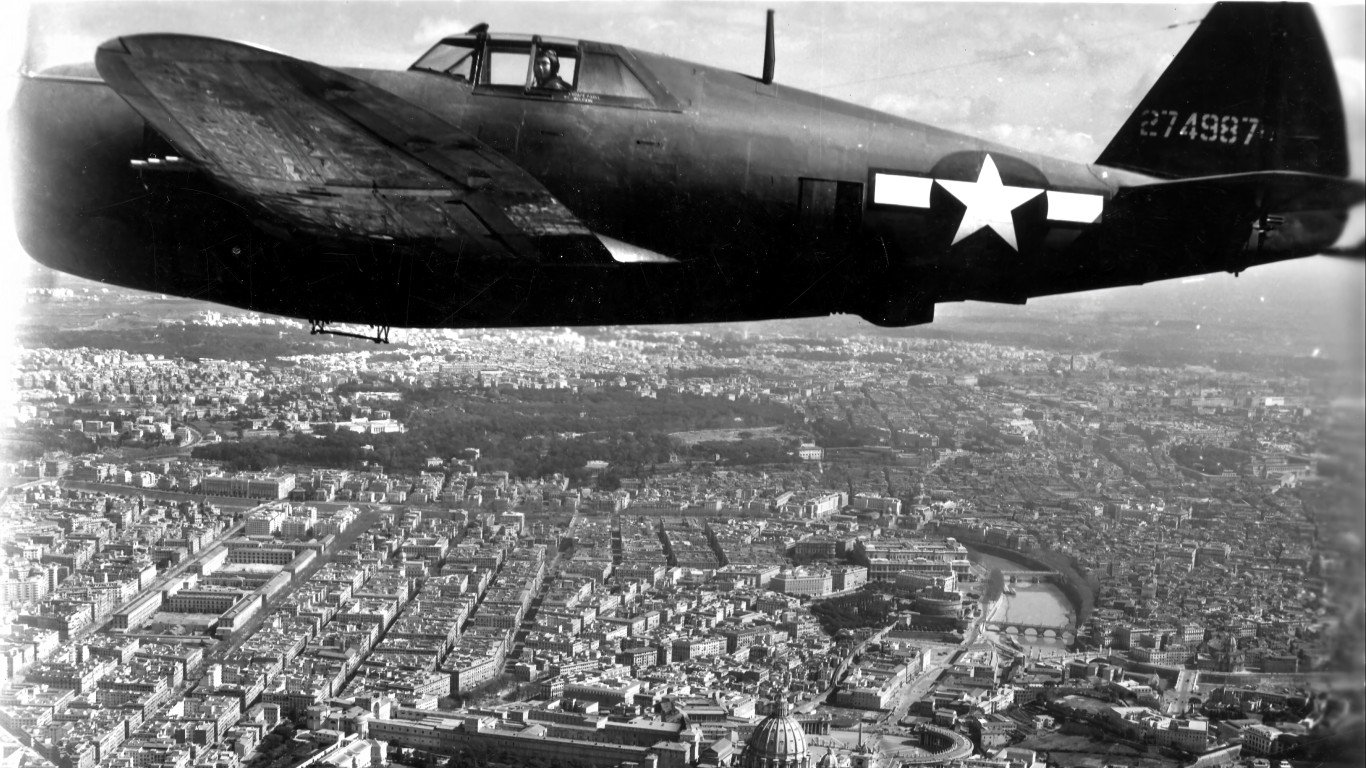

How fast were American planes during World War II? The United States designed a variety of state-of-the-art aircraft, with many showcasing remarkable speeds for that era. The introduction of jet propulsion before the U.S. entered the war signaled the beginning of a new era in aviation. (Here are the most mass-produced planes in World War II.)
The involvement of the United States in World War II bolstered the Allied Forces, with American factories playing a pivotal role in manufacturing thousands of aircraft and other essential resources for the war effort. This substantial contribution played a key role in tilting the balance in favor of the Allies. These aircraft represent a milestone in the evolution of aviation and the military, with certain models becoming iconic symbols of war.
To determine the fastest American military planes from WWII, 24/7 Wall St. reviewed WW2 Aircraft Ranked-by-Speed, a list compiled by Military Factory, an online database of military vehicles, aircraft, arms, and more. Only military planes that had production runs of more than 150 and that served during the war were included, ranking them based on their top speed. Prototypes and concept aircraft were excluded. Supplemental information about the year the craft entered service, crew size, and roles also came from Military Factory.
Two standout airplanes are the P-51 Mustang and the P-38 Lightning, known for their speed, agility, and influence on the war’s outcome.
The P-51 Mustang became one of the most iconic and fastest American planes during World War II. Its impressive range (exceeding 950 miles), coupled with its incredible speed and weaponry, transformed the P-51 Mustang into a formidable aircraft. The P-51 Mustang directly impacted the success of strategic bombing campaigns against Axis forces. It could slice through the air at speeds up to 437 mph and was primarily deployed as a long-range escort for bomber raids over Germany.
Another impressively fast American aircraft was the P-38 Lightning, known for its unique twin-engine design. With its turbo-supercharged engines, the P-38 could reach outstanding speeds of 414 mph. Its versatility made the P-38 a diverse aircraft with multiple roles, ranging from interception and dive bombing to ground attack and reconnaissance missions.
Why This Matters
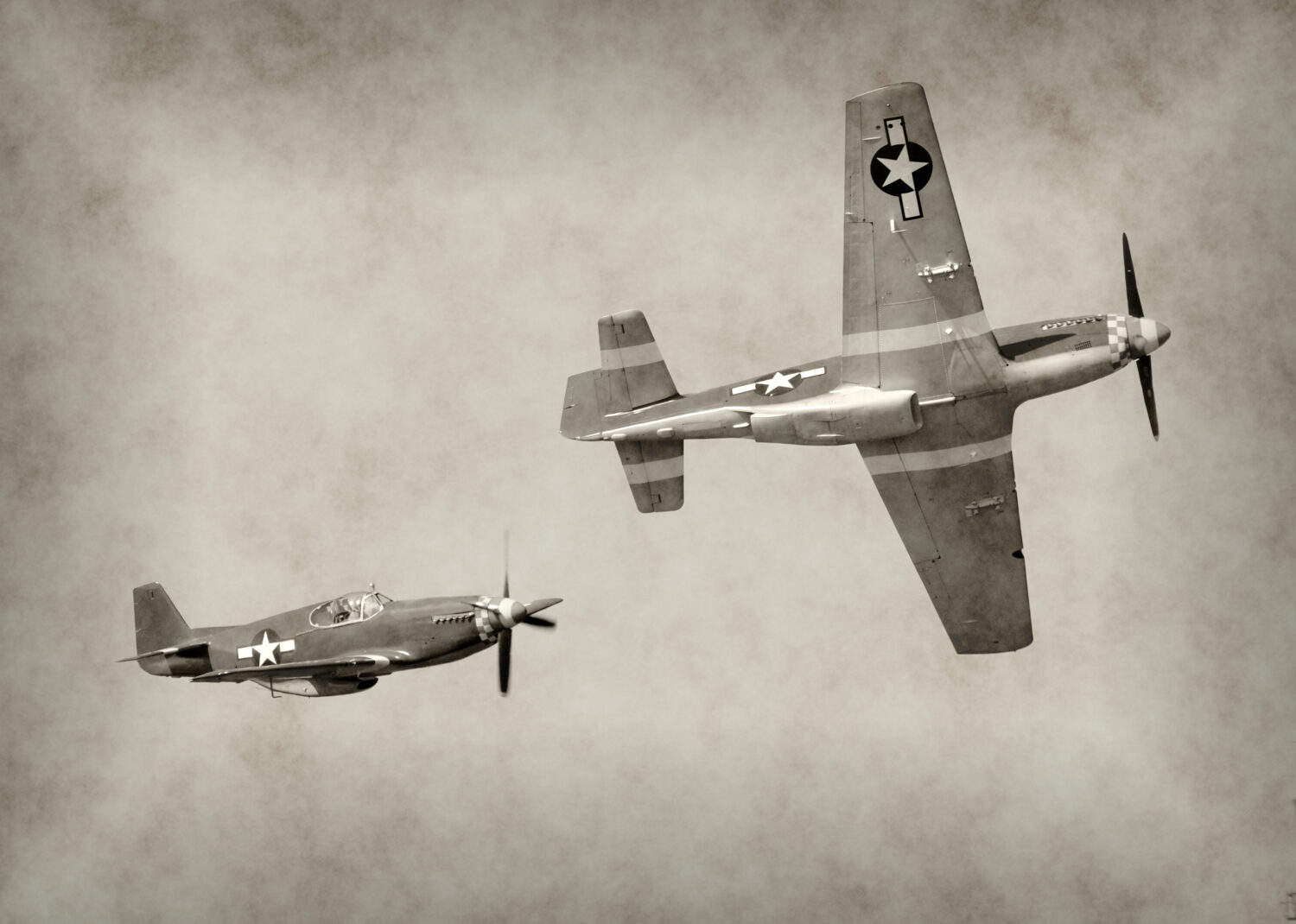
World War II brought about a dramatic shift in technology. This was especially true in aviation, as new aircraft emerged that far surpassed anything used just a few decades earlier. These new American planes incorporated the latest technology, fundamentally changing the technical aspects of warfare and how soldiers and pilots approached fighting. Understanding the fastest and slowest American planes used in World War II illustrates the scale and impact of aviation on the war and those fighting in it.
Here are the fastest and slowest aircraft fielded by the United States in WWII:
66. Piper L-4 Grasshopper
The Piper L-4 Grasshopper is a single-crew aircraft that entered service in 1941 with a production run of 5,500. It played a role in surveillance and reconnaissance, with a top speed of 85 mph.
65. Stinson L-1 Vigilant (Model 74)
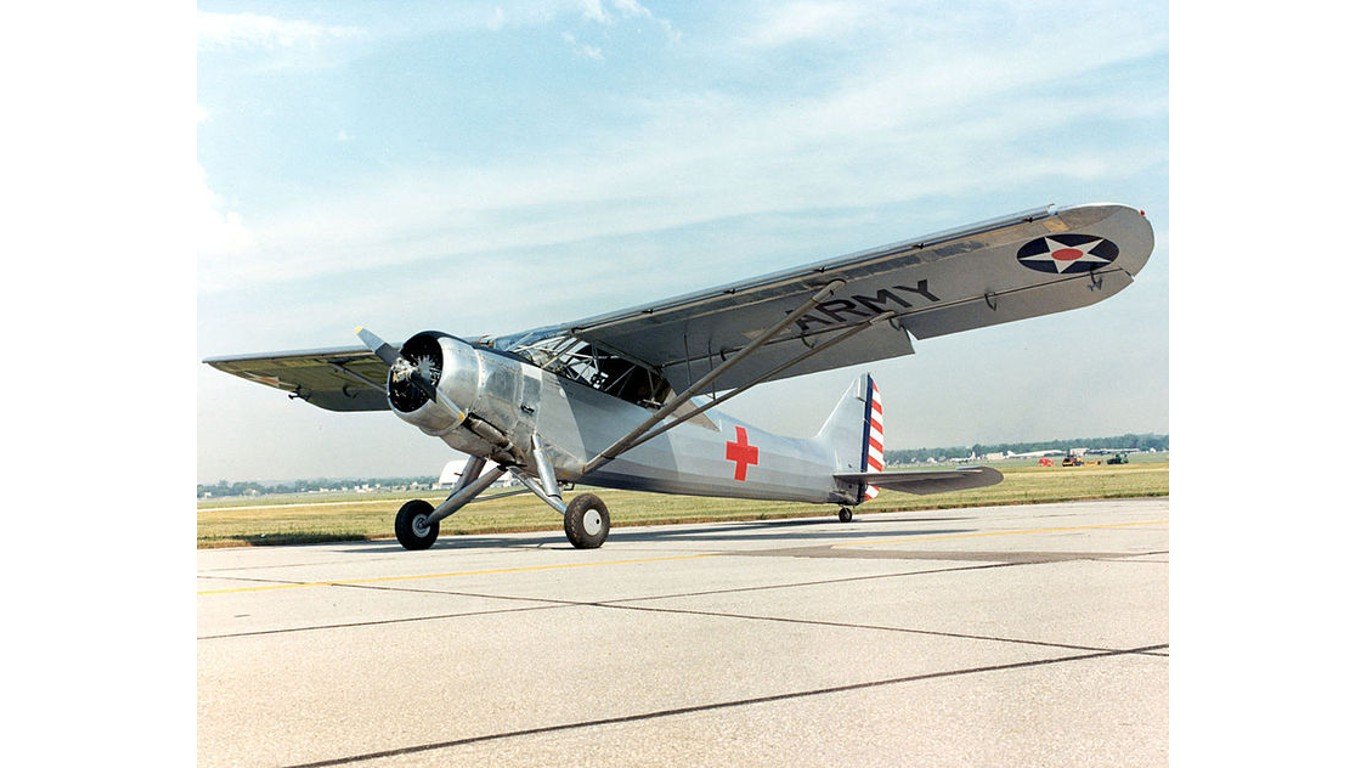
The Stinson L-1 Vigilant (Model 74) entered service in 1941 with a production run of 324 and a three-member crew aircraft. It played a role in special missions, surveillance, reconnaissance, and training, with a top speed of 121 mph.
64. Naval Aircraft Factory N3N (Yellow Peril)
The Naval Aircraft Factory N3N (Yellow Peril) entered service in 1936 with a production run of 997 and a two-person crew. It played a role in training, with a top speed of 127 mph.
63. Stinson L-5 Sentinel
The Stinson L-5 Sentinel entered service in 1942 with a production run of 3,896 and a two-person crew. It played a role in close-air support, special missions, maritime, surveillance, and reconnaissance, with a top speed of 165 mph.
62. Curtiss SOC Seagull
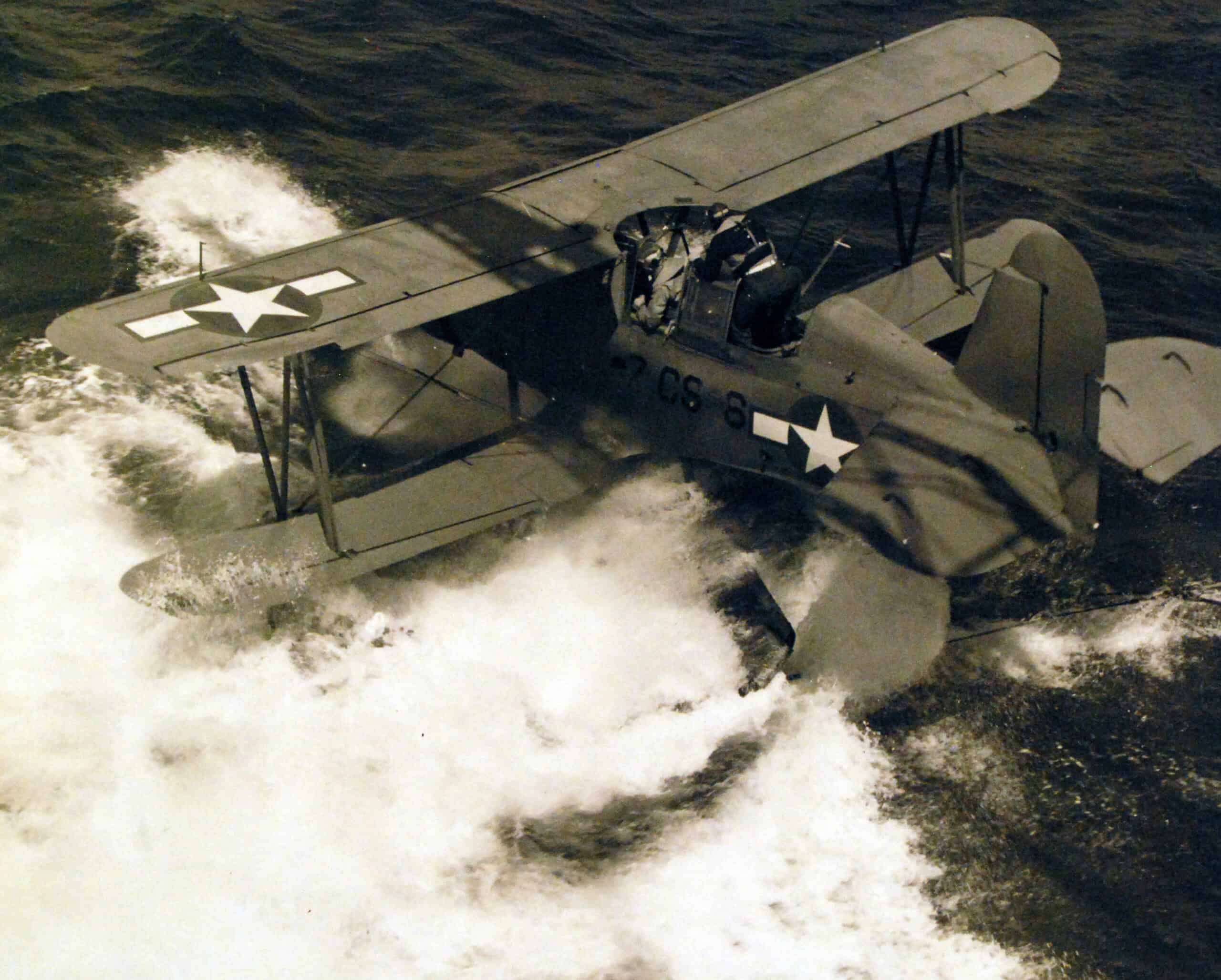
The Curtiss SOC Seagull entered service in 1935 with a production run of 332 and a two-person crew. It played a role in ground attacks, special missions, surveillance, reconnaissance, and training, with a top speed of 165 mph.
61. Curtiss SO3C Seamew
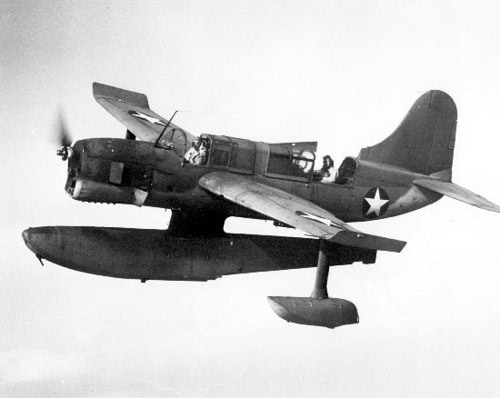
The Curtiss SO3C Seamew entered service in 1942 with a production run of 796 and a two-person crew. It played a role in maritime, surveillance, and reconnaissance, with a top speed of 172 mph.
60. Stinson Reliant
The Stinson Reliant entered service in 1933 with a production run of 1,327 and a single-person crew. It played a role in training, surveillance, and reconnaissance, with a top speed of 177 mph.
59. Consolidated PBY Catalina
The Consolidated PBY Catalina entered service in 1936 with a production run of 3,305 and a 10-person crew. It played a role in ground attack, transport, surveillance, and reconnaissance, with a top speed of 179 mph.
58. Vultee BT-13 Valiant
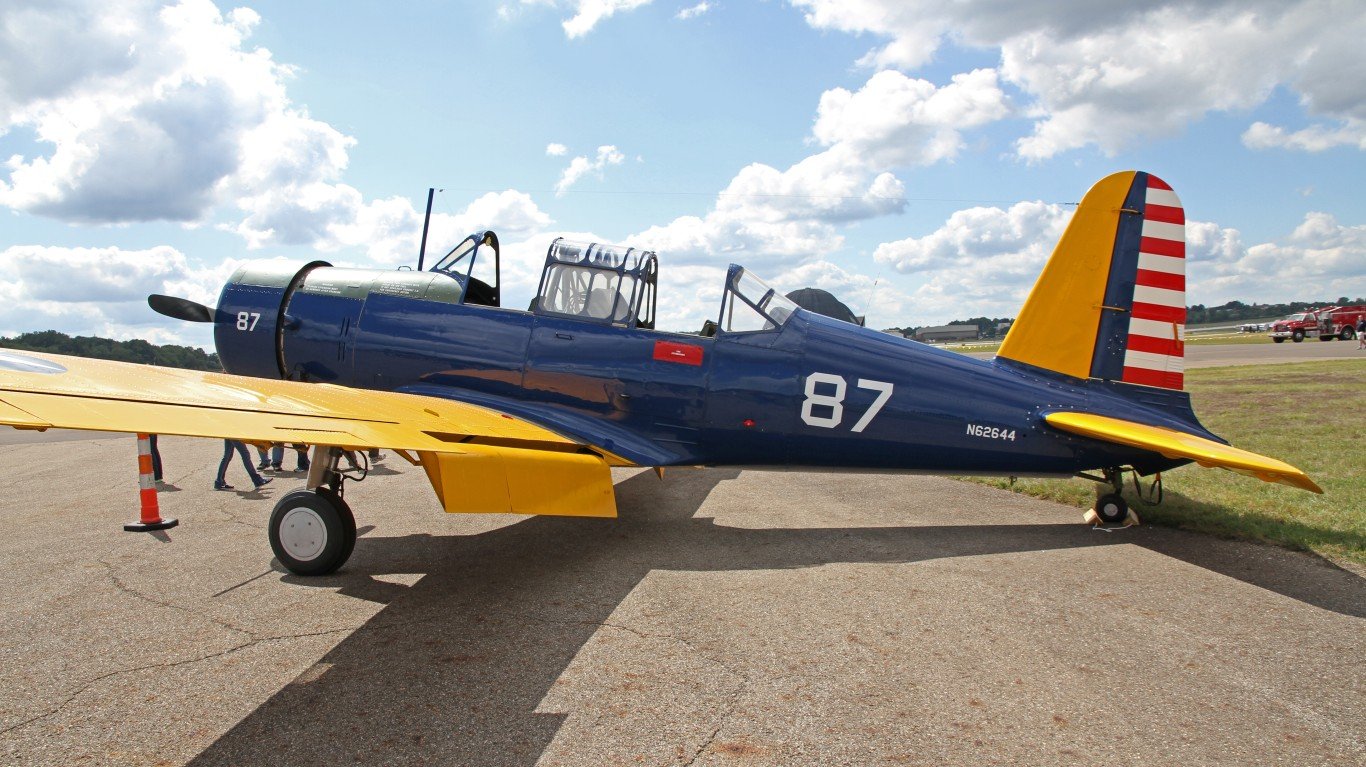
The Vultee BT-13 Valiant entered service in 1939 with a production run of 11,537 and a two-person crew. It played a role in training, with a top speed of 183 mph.
57. Grumman J2F Duck

The Grumman J2F Duck entered service in 1936 with a production run of 564 and a two-person crew. It played a role in special missions and maritime warfare, with a top speed of 189 mph.
56. Beech AT-10 Wichita
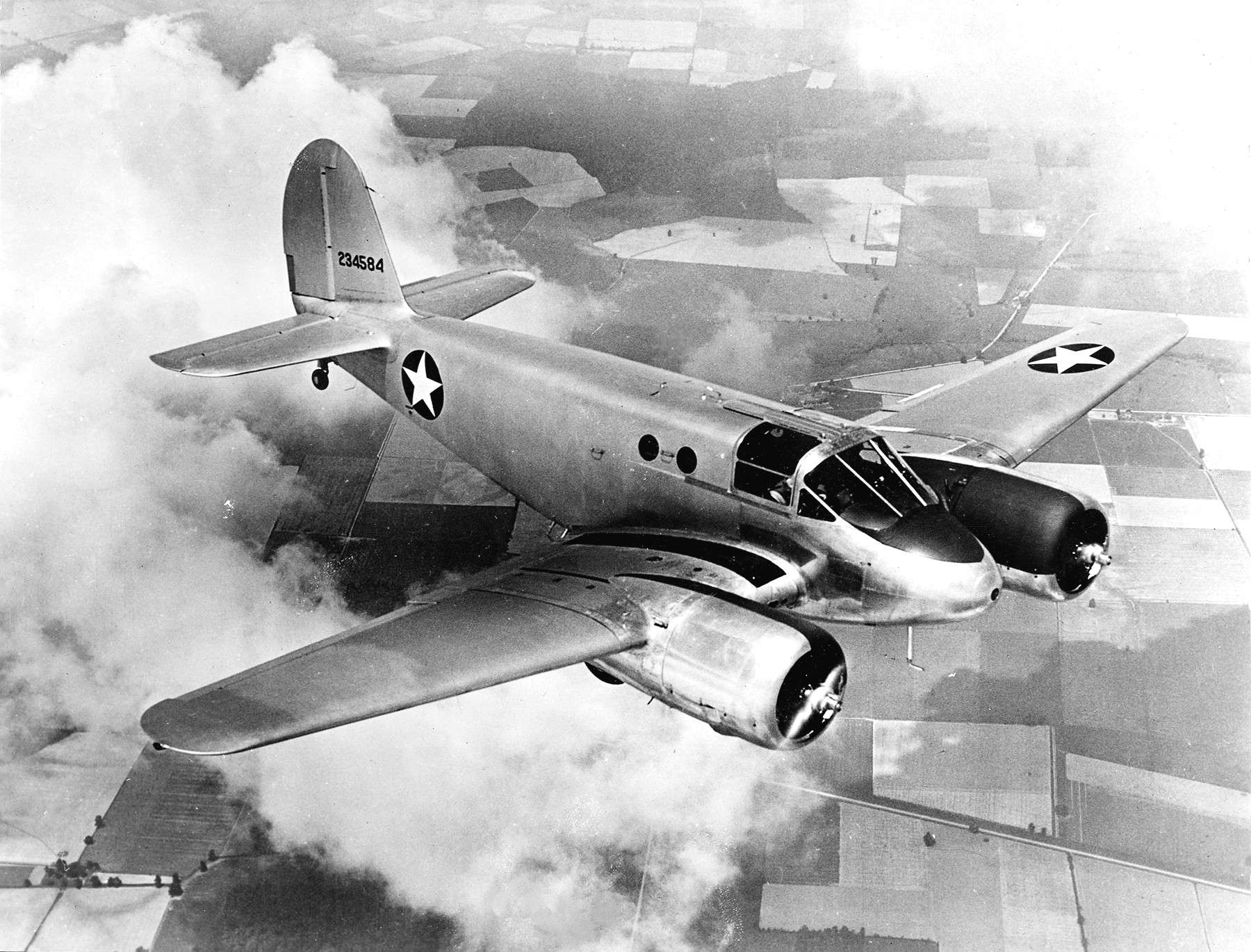
The Beech AT-10 Wichita entered service in 1942 with a production run of 2,371 and a two-person crew. It played a role in training, with a top speed of 199 mph.
55. Grumman Goose (G-21)

The Grumman Goose (G-21) entered service in 1937 with a production run of 345 and a two-person crew. It played a role in transport, training, surveillance, and reconnaissance, with a top speed of 201 mph.
54. Northrop A-17 (Nomad)
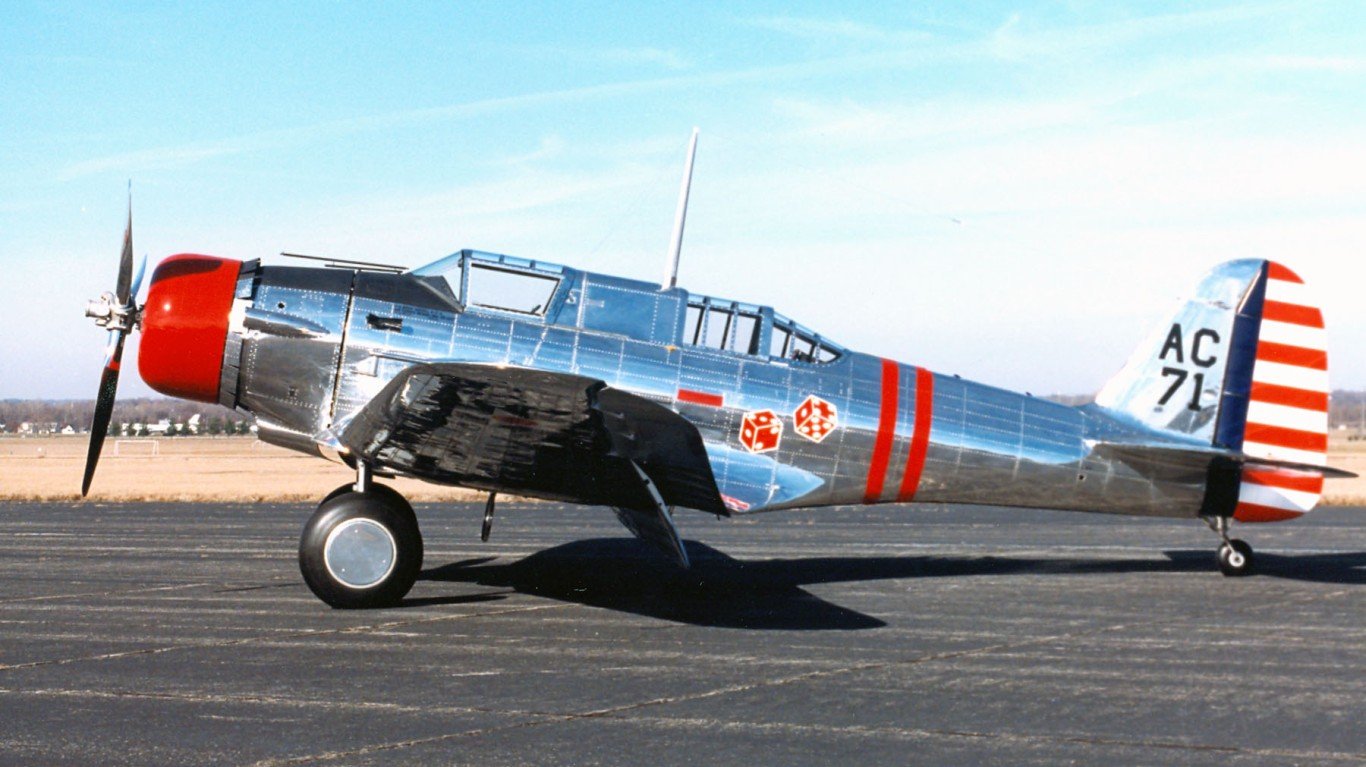
The Northrop A-17 (Nomad) entered service in 1935 with a production run of 411 and a two-person crew. It played a role in ground attacks, close-air support, surveillance, and reconnaissance, with a top speed of 208 mph.
53. North American T-6 Texan
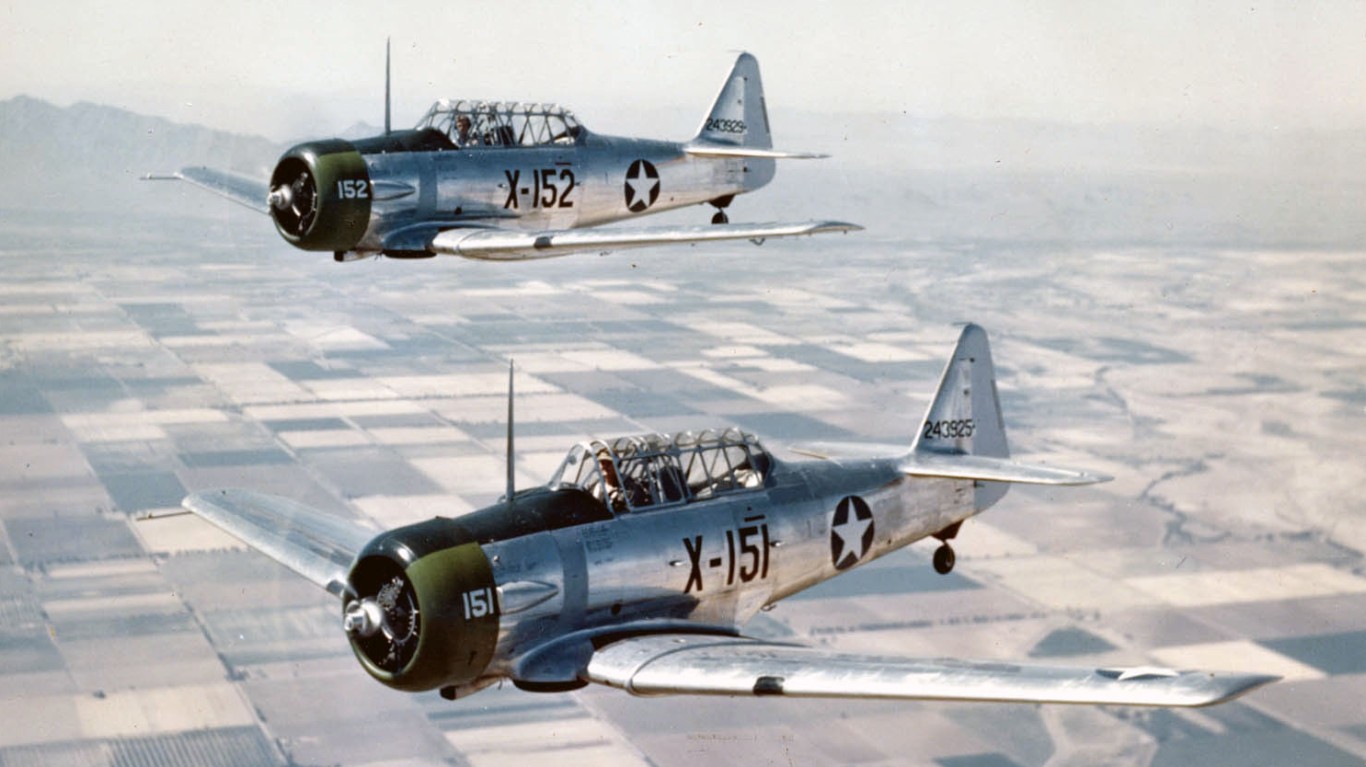
The North American T-6 Texan entered service in 1936 with a production run of 15,495 and a two-person crew. It played a role in close-air support and training, with a top speed of 209 mph.
52. Beech AT-11 Kansan
The Beech AT-11 Kansan entered service in 1937 with a production run of 1,606 and a six-person crew. It played a role in ground attacks and training, with a top speed of 214 mph.
51. Douglas B-18 Bolo
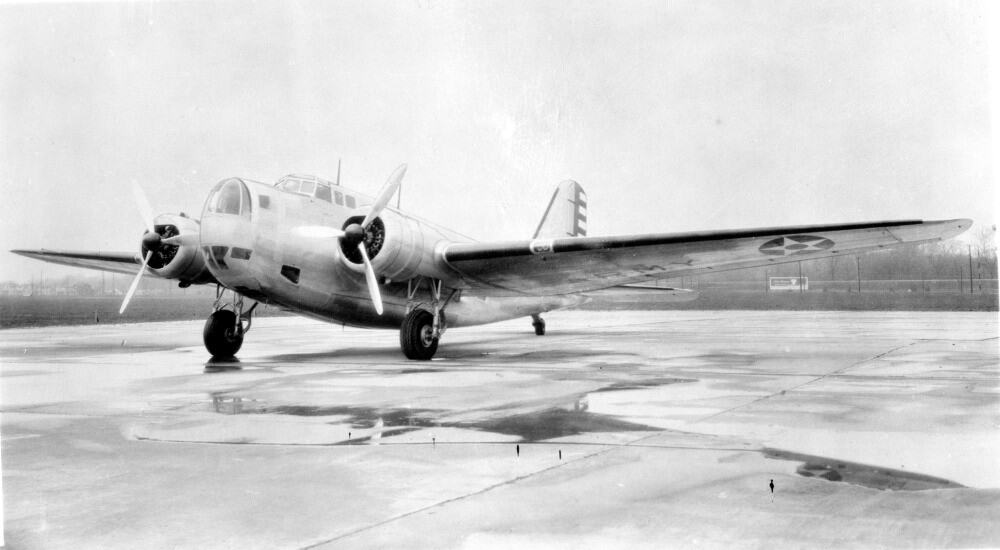
The Douglas B-18 Bolo entered service in 1936 with a production run of 360 and a six-person crew. It played a role in ground attacks, special missions, transport, surveillance, and reconnaissance, with a top speed of 215 mph.
50. Curtiss O-52 Owl

The Curtiss O-52 Owl entered service in 1941 with a production run of 203 and a two-person crew. It played a role in surveillance and reconnaissance, with a top speed of 221 mph.
49. Consolidated PB2Y Coronado
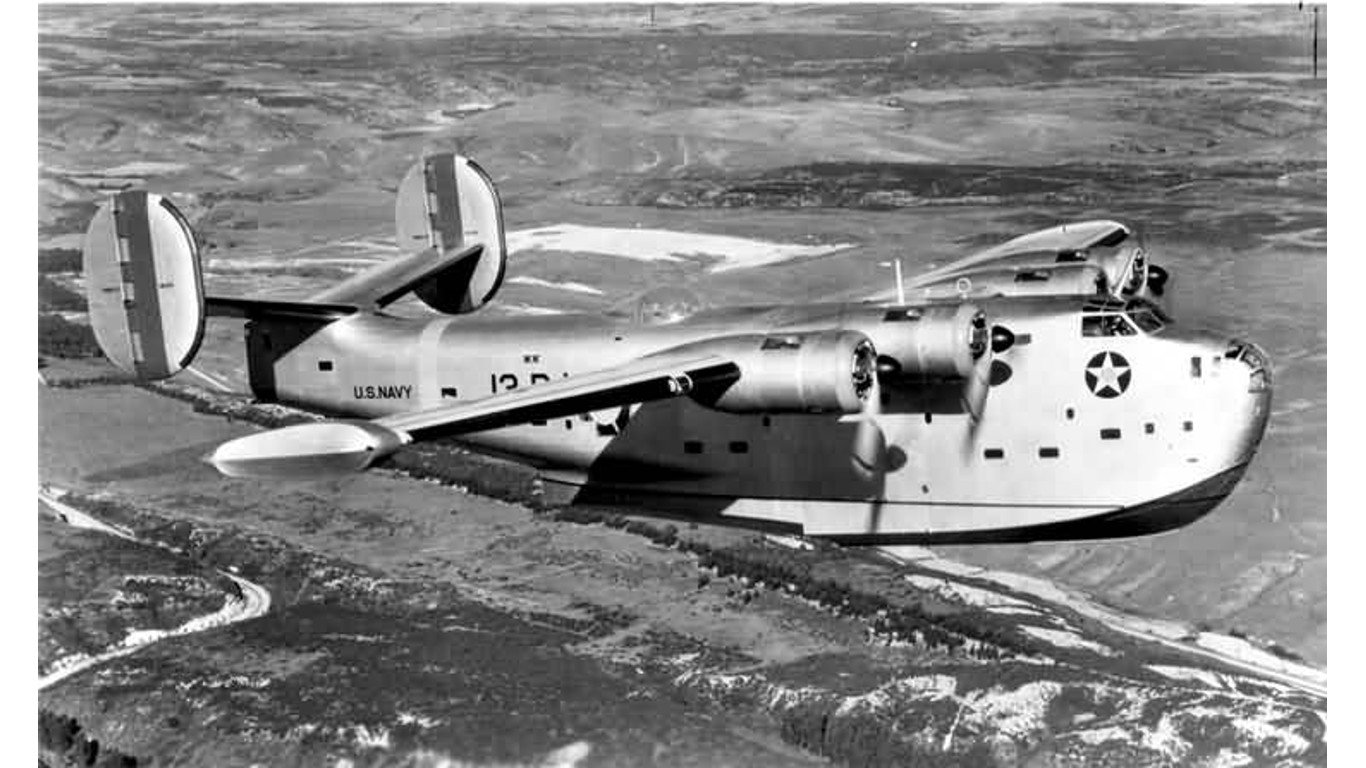
The Consolidated PB2Y Coronado entered service in 1940 with a production run of 217 and a 10-person crew. It played a role in ground attacks, surveillance, and reconnaissance, with a top speed of 223 mph.
48. Beechcraft C-45 (Expeditor)

The Beechcraft C-45 (Expeditor) entered service in 1941 with a production run of 1,300 and a nine-person crew. It played a role in transport, with a top speed of 224 mph.
47. Boeing P-26 Peashooter
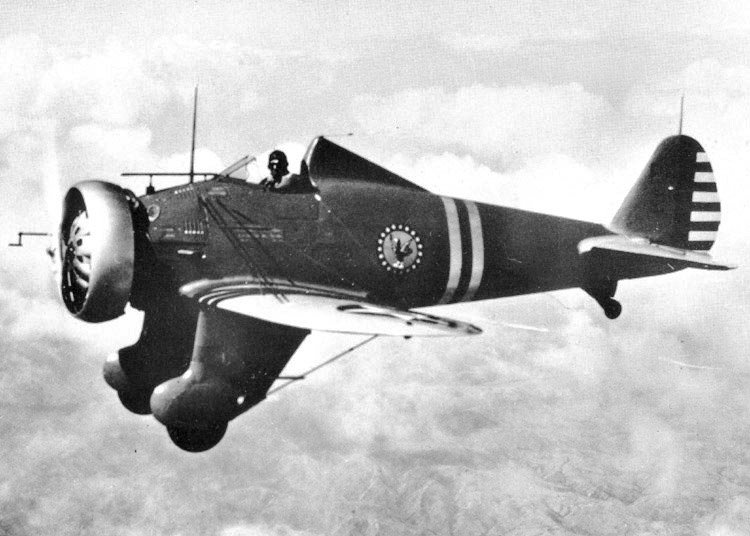
The Boeing P-26 Peashooter entered service in 1932 with a production run of 151 and a single-person crew. It played a role in air-to-air combat fighting with a top speed of 227 mph.
46. Douglas C-47 (Skytrain / Dakota)
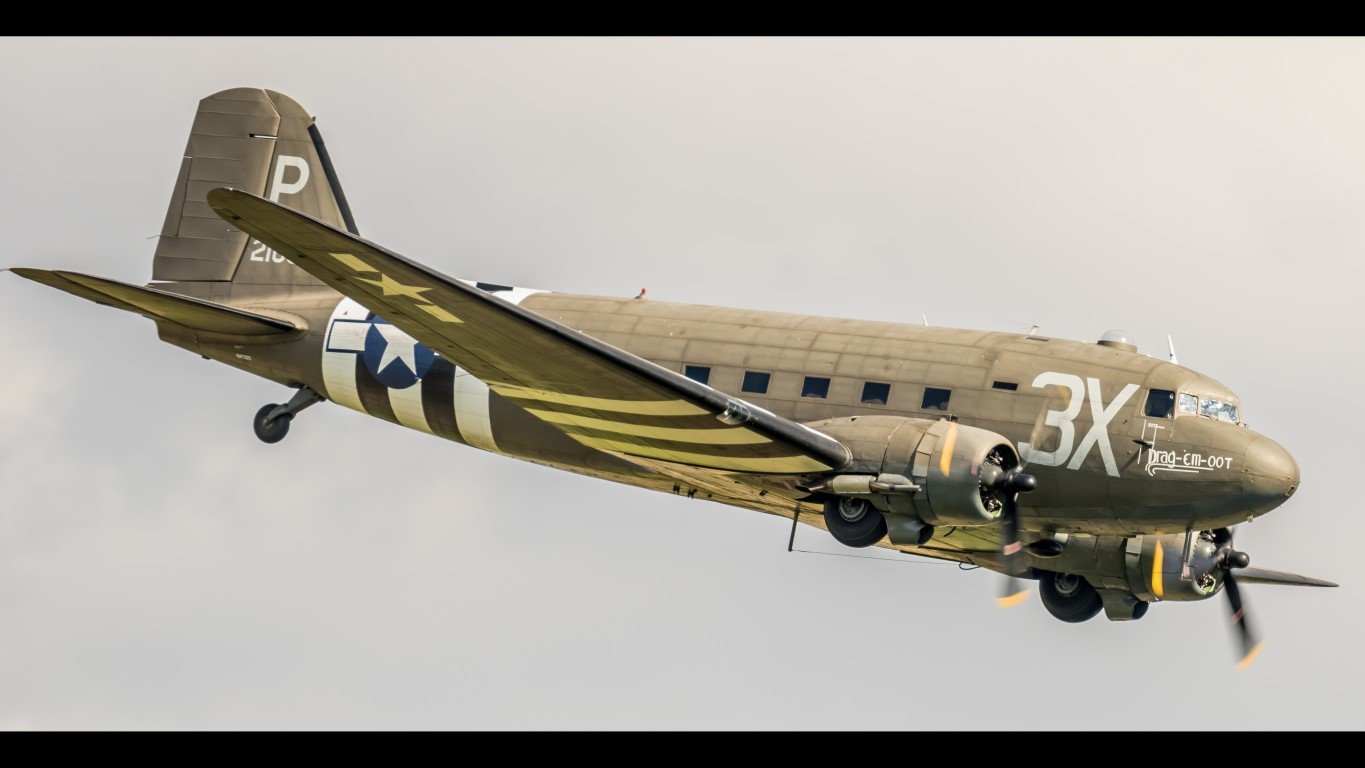
The Douglas C-47 (Skytrain / Dakota) entered service in 1942 with a production run of 12,748 and a three-person crew. It played a role in ground attacks, close-air support, and transport, with a top speed of 230 mph.
45. Curtiss SBC Helldiver
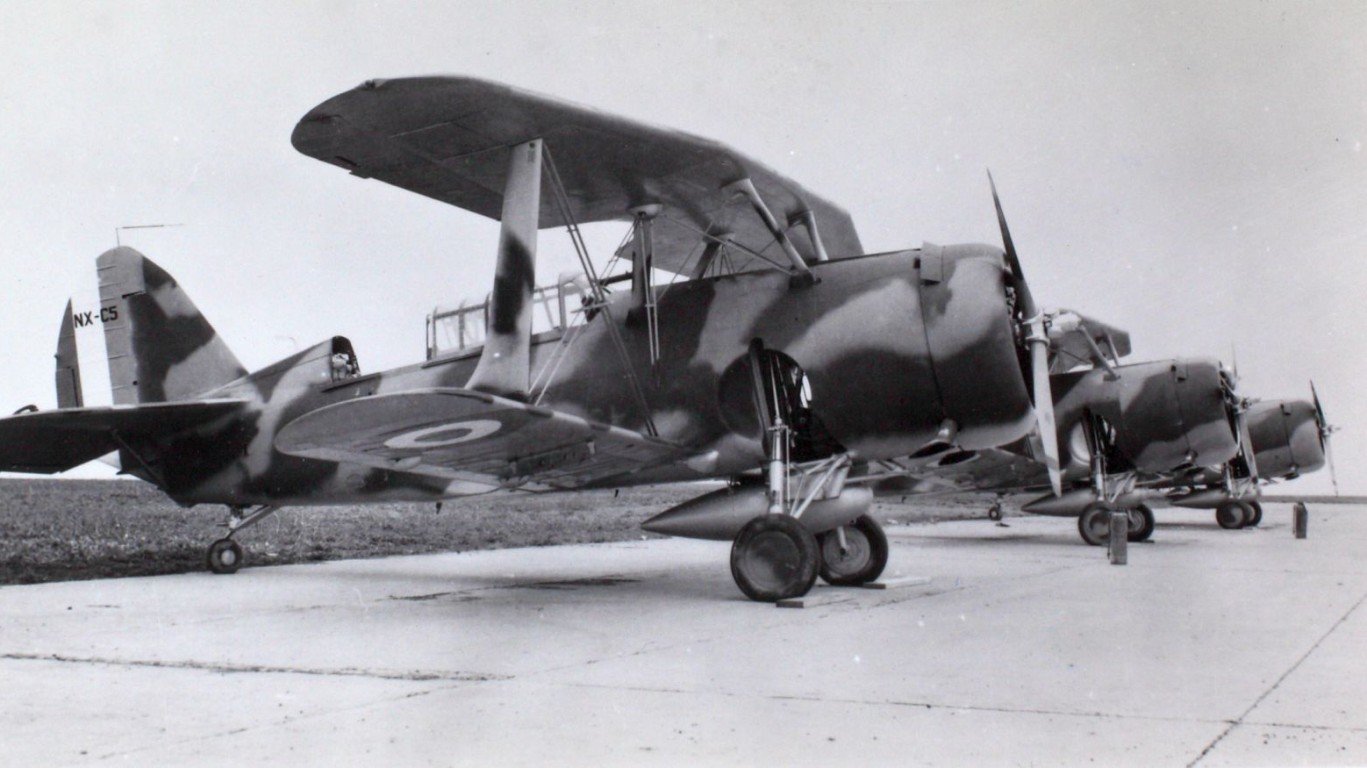
The Curtiss SBC Helldiver entered service in 1938 with a production run of 257 and a two-person crew. It played a role in air-to-air combat fighting, ground attacks, and special missions, with a top speed of 237 mph.
44. Lockheed Hudson
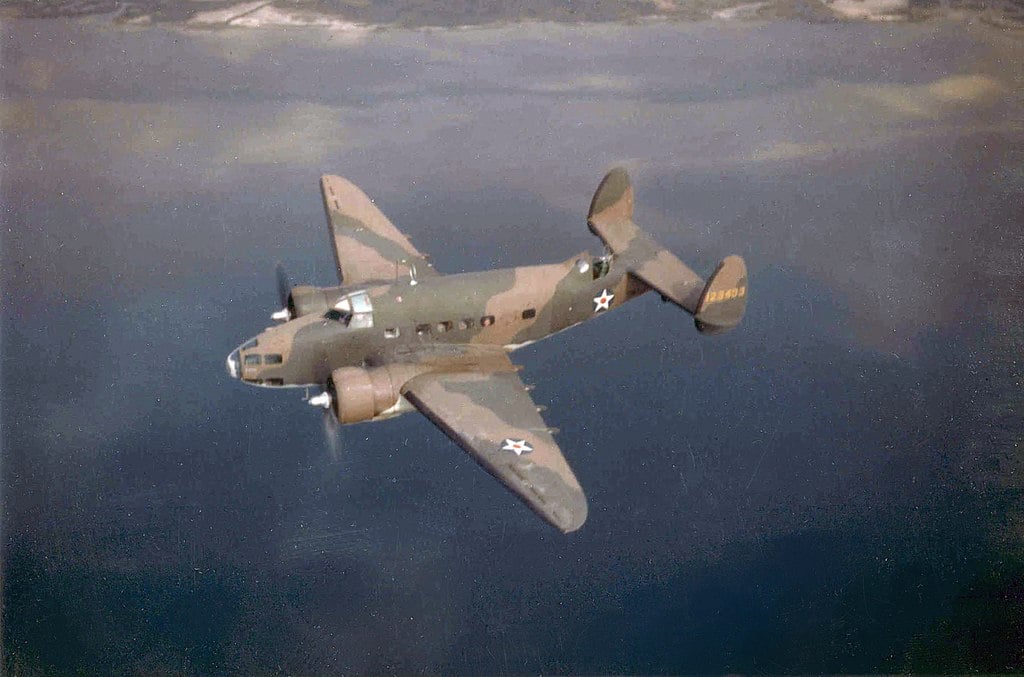
The Lockheed Hudson entered service in 1939 with a production run of 2,941 and a six-person crew. It played a role in ground attacks, transport, surveillance, reconnaissance, and training, with a top speed of 249 mph.
43. Douglas A-24 Banshee

The Douglas A-24 Banshee entered service in 1941 with a production run of 953 and a two-person crew. It played a role in ground attacks, close-air support, surveillance, reconnaissance, and training, with a top speed of 250 mph.
42. Vought SB2U Vindicator
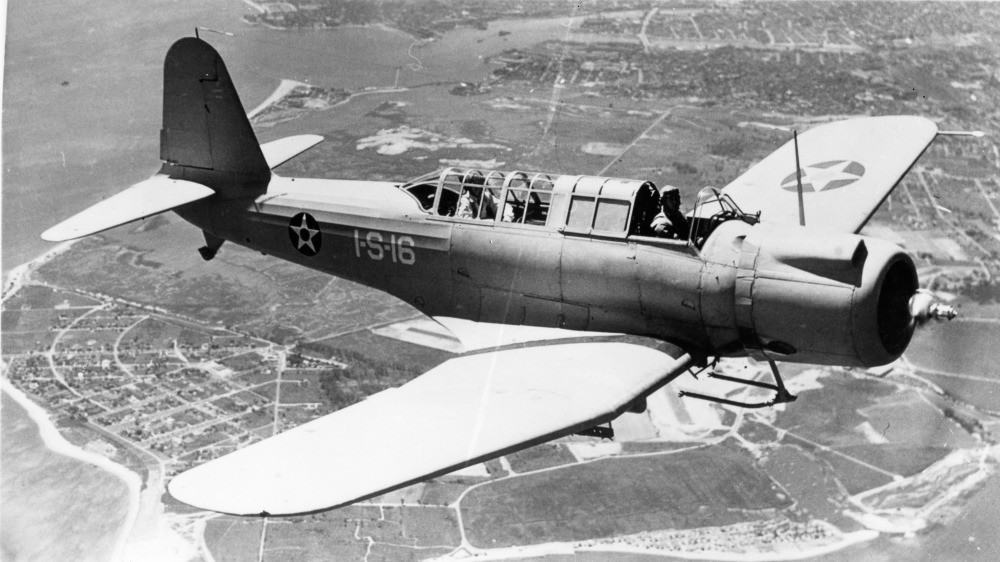
The Vought SB2U Vindicator entered service in 1937 with a production run of 260 and a two-person crew. It played a role in ground attacks, special missions, and training, with a top speed of 251 mph.
41. Douglas SBD Dauntless

The Douglas SBD Dauntless entered service in 1938 with a production run of 5,936 and a two-person crew. It played a role in ground attacks and special missions, with a top speed of 255 mph.
40. Curtiss SB2C Helldiver
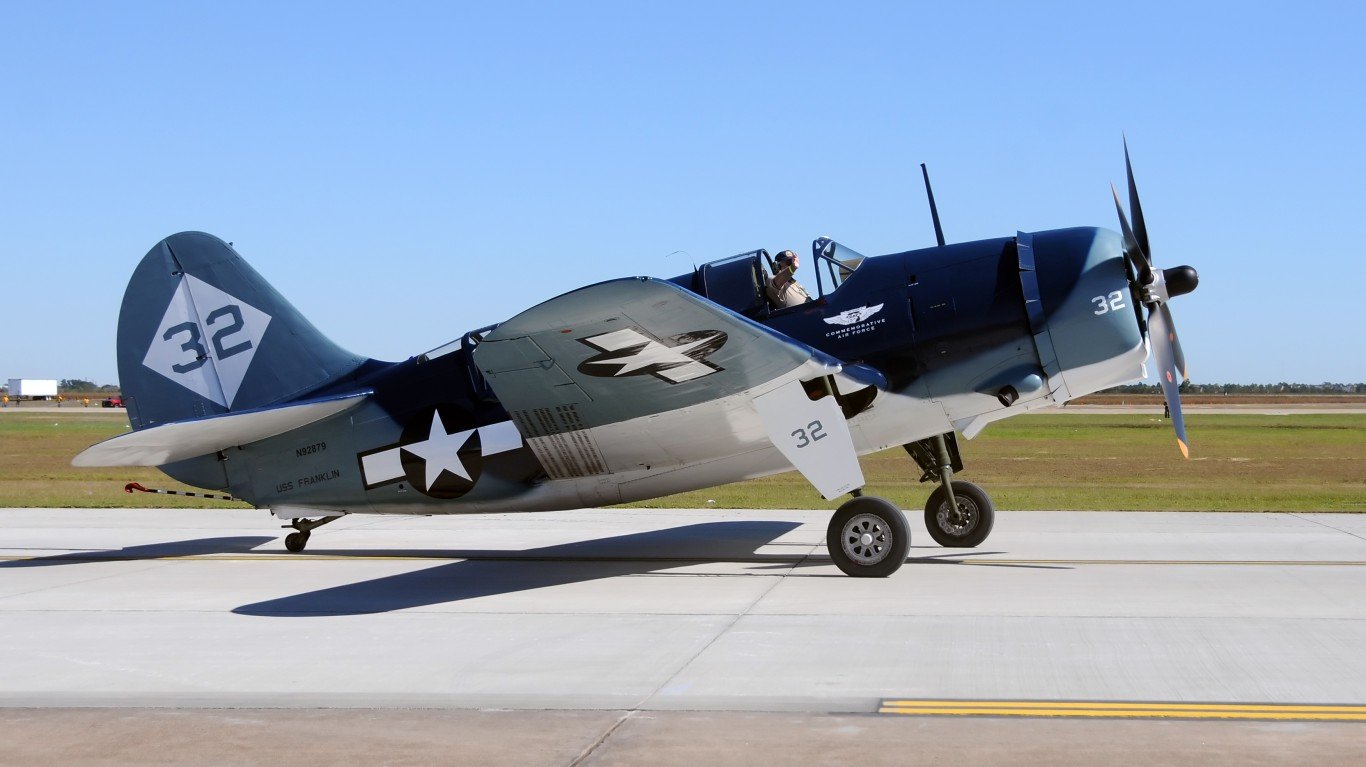
The Curtiss SB2C Helldiver entered service in 1943 with a production run of 7,140 and a two-person crew. It played a role in ground attacks, special missions, surveillance, and reconnaissance, with a top speed of 260 mph.
39. Curtiss-Wright C-46 Commando
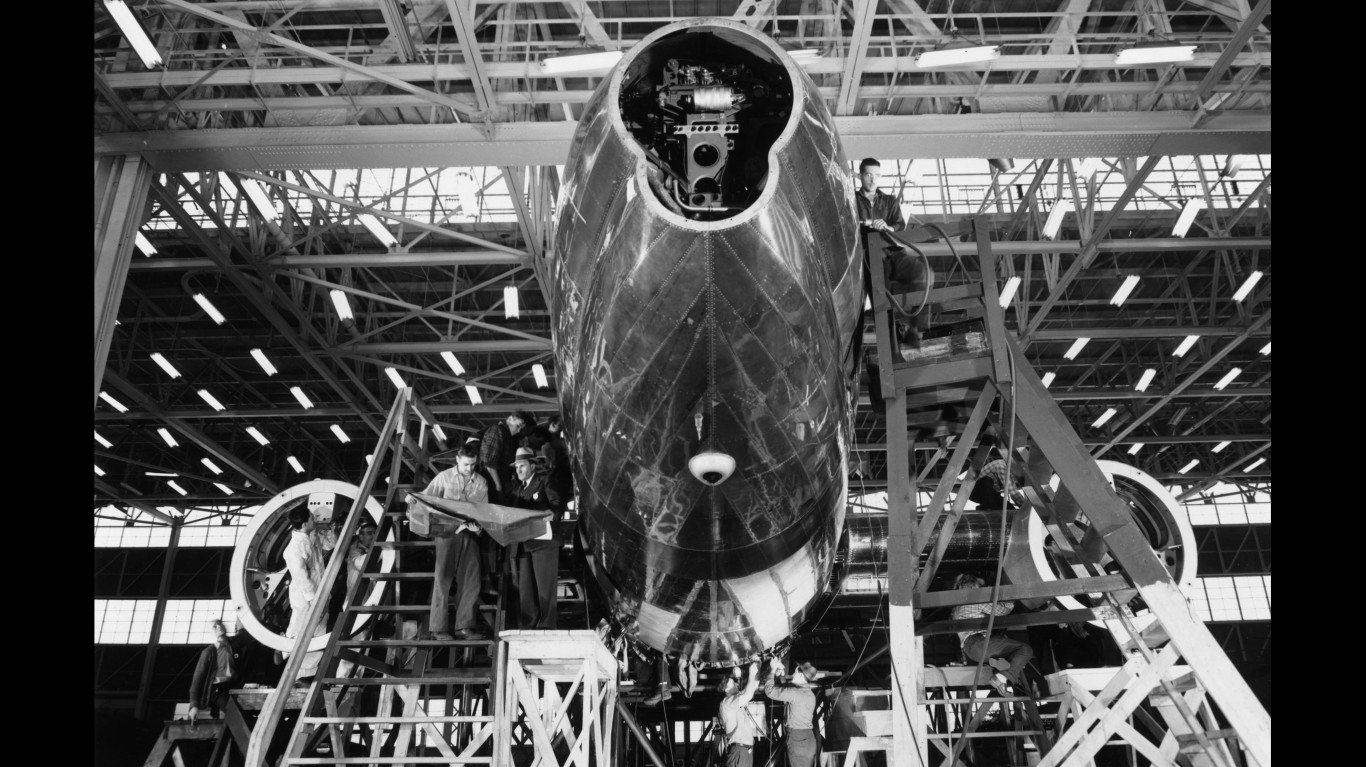
The Curtiss-Wright C-46 Commando entered service in 1941 with a production run of 3,181 and a four-person crew. It played a role in transport, with a top speed of 270 mph.
38. Grumman TBF Avenger
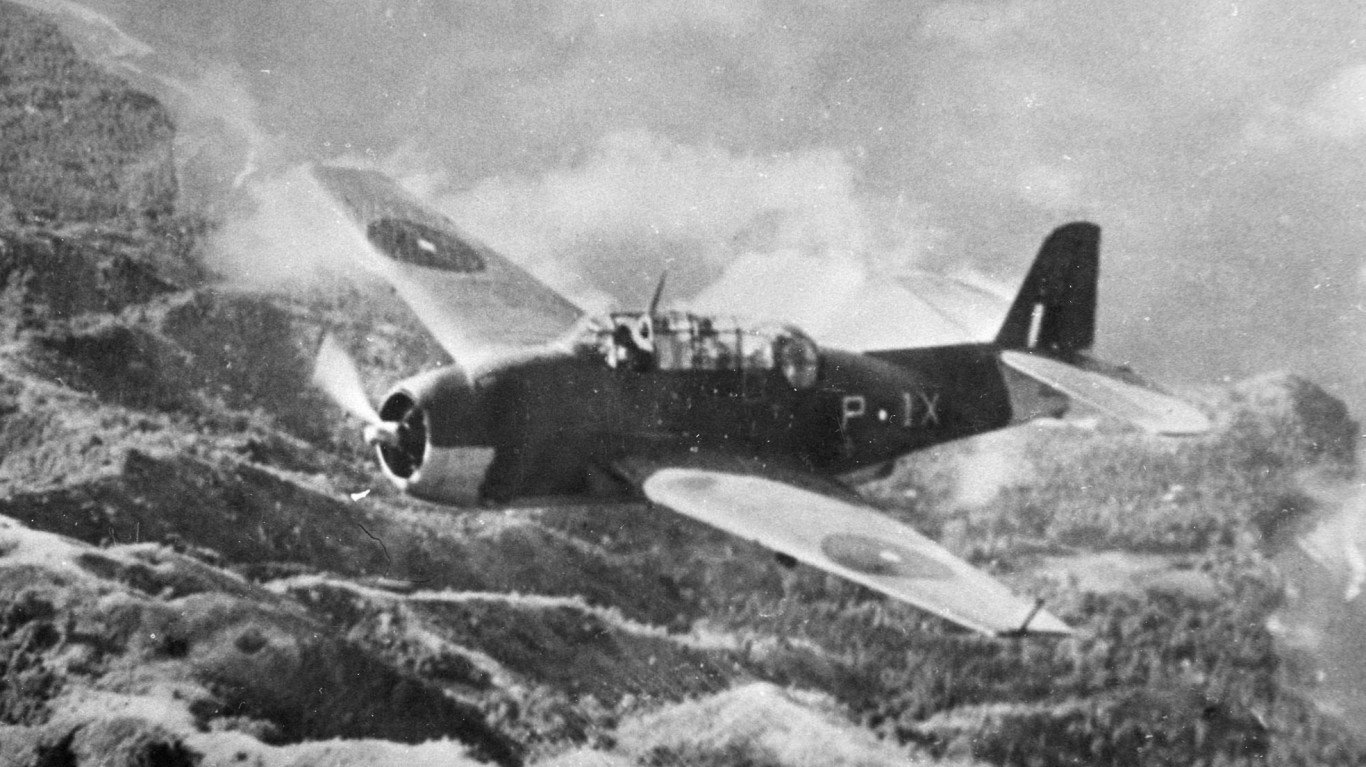
The Grumman TBF Avenger entered service in 1942 with a production run of 9,835 and a three-person crew. It played a role in air-to-air combat fighting, ground attacks, special missions, surveillance, and reconnaissance, with a top speed of 271 mph.
37. North American B-25 Mitchell

The North American B-25 Mitchell entered service in 1941 with a production run of 9,816 and a five-person crew. It played a role in ground attacks, close-air support, special missions, transport, surveillance, reconnaissance, and training, with a top speed of 272 mph.
36. Brewster SB2A Buccaneer
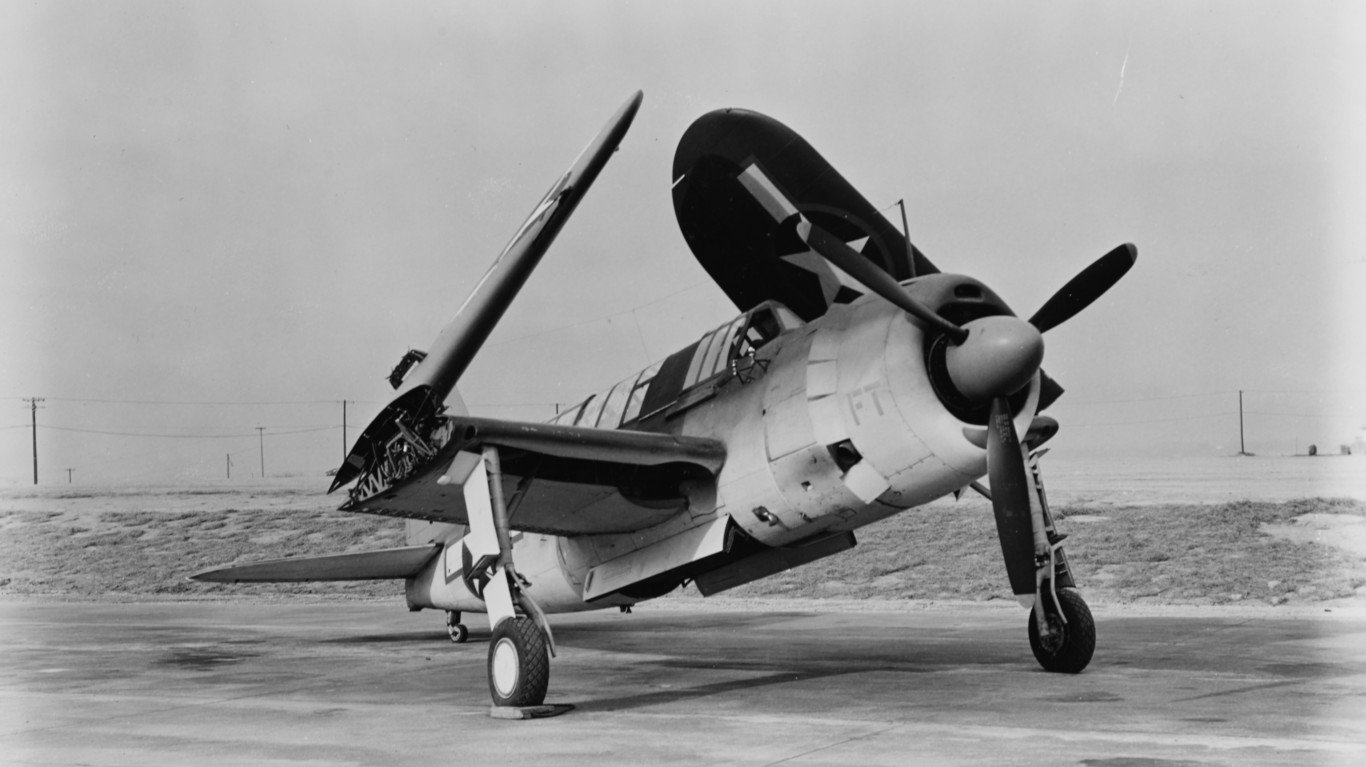
The Brewster SB2A Buccaneer entered service in 1941 with a production run of 771 and a two-person crew. It played a role in ground attacks, maritime warfare, surveillance, and reconnaissance, with a top speed of 273 mph.
35. Douglas C-54 Skymaster (DC-4)

The Douglas C-54 Skymaster (DC-4) entered service in 1942 with a production run of 1,170 and a four-person crew. It played a role in transport, with a top speed of 275 mph.
34. Vultee A-35 Vengeance
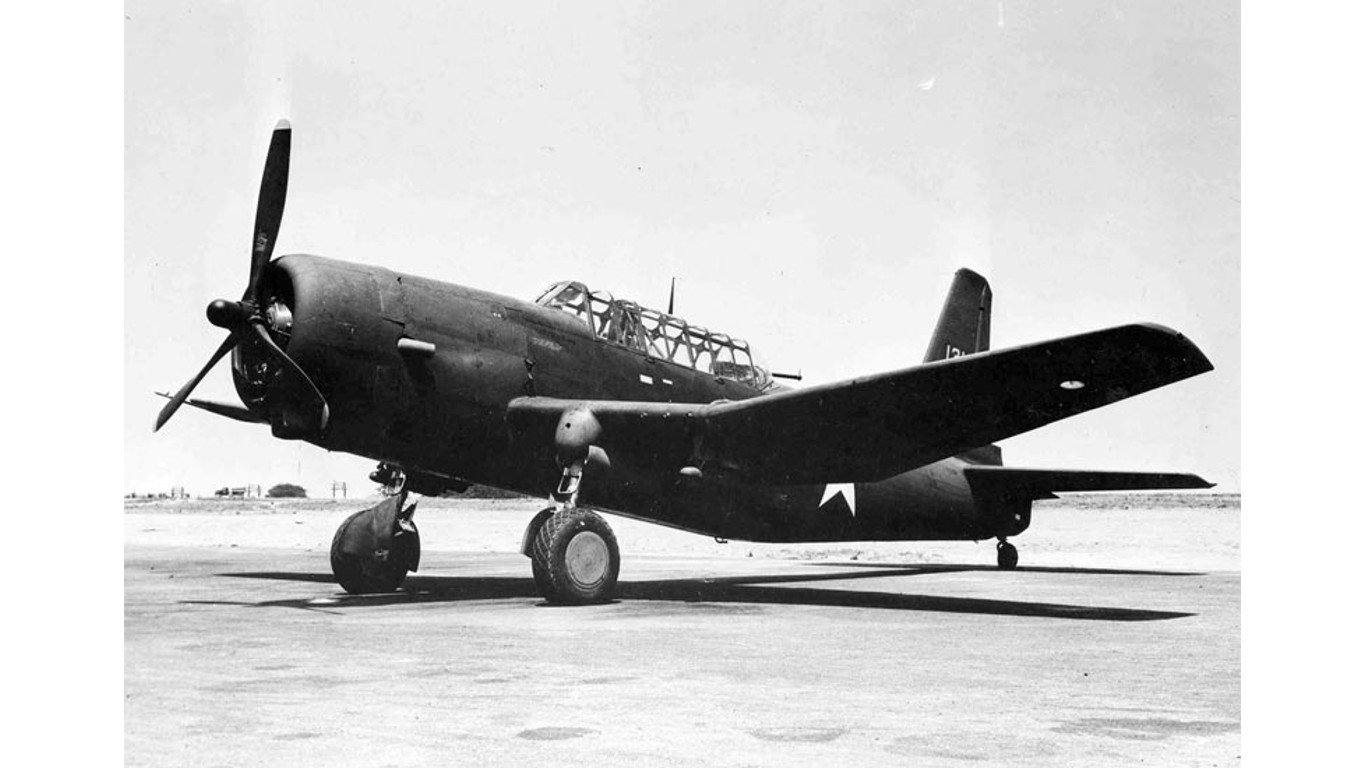
The Vultee A-35 Vengeance entered service in 1941 with a production run of 1,962 and a two-person crew. It played a role in ground attacks, with a top speed of 279 mph.
33. Martin B-26 Marauder

The Martin B-26 Marauder entered service in 1941 with a production run of 5,288 and a seven-person crew. It played a role in ground attacks and training, with a top speed of 282 mph.
32. Boeing B-17 Flying Fortress
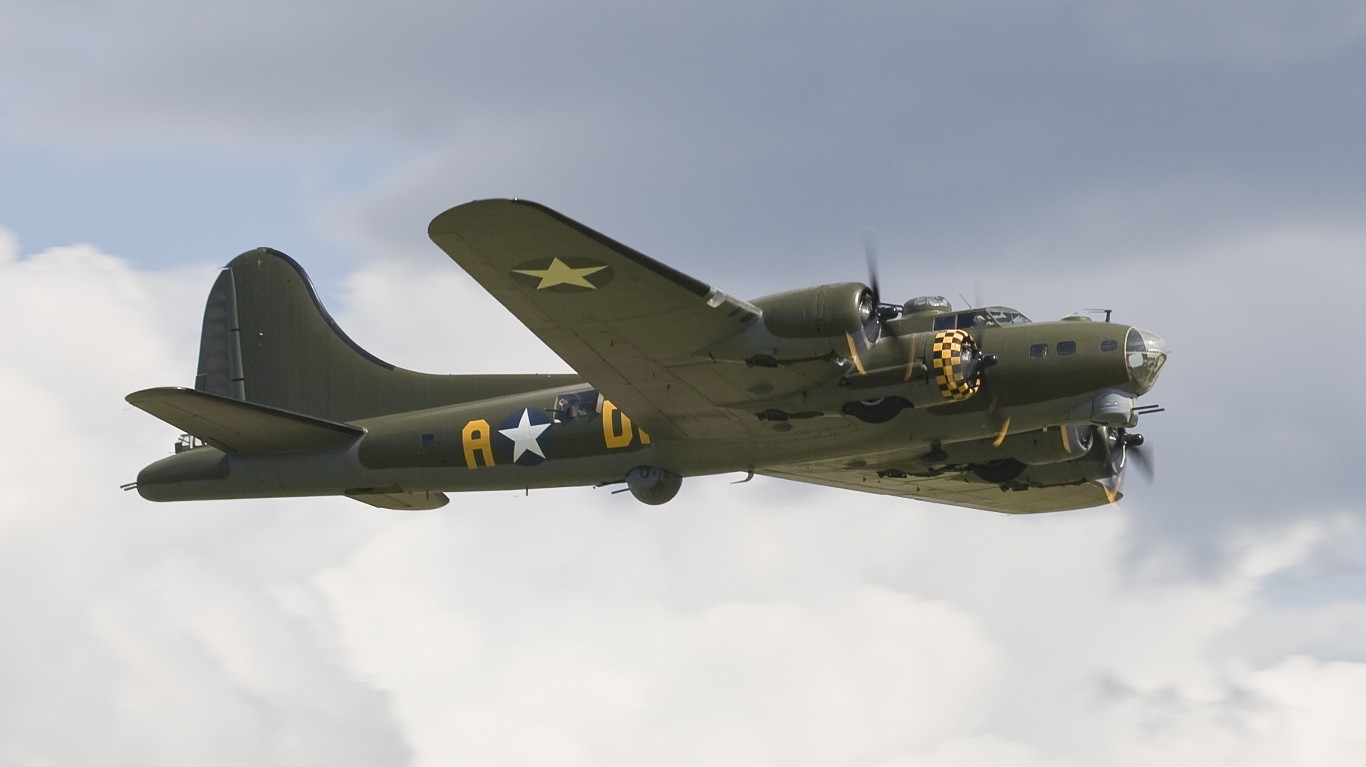
The Boeing B-17 Flying Fortress entered service in 1937 with a production run of 12,731 and a 10-person crew. It played a role in ground attacks, close-air support, special missions, transport, surveillance, reconnaissance, and training, with a top speed of 287 mph.
31. Consolidated B-24 Liberator
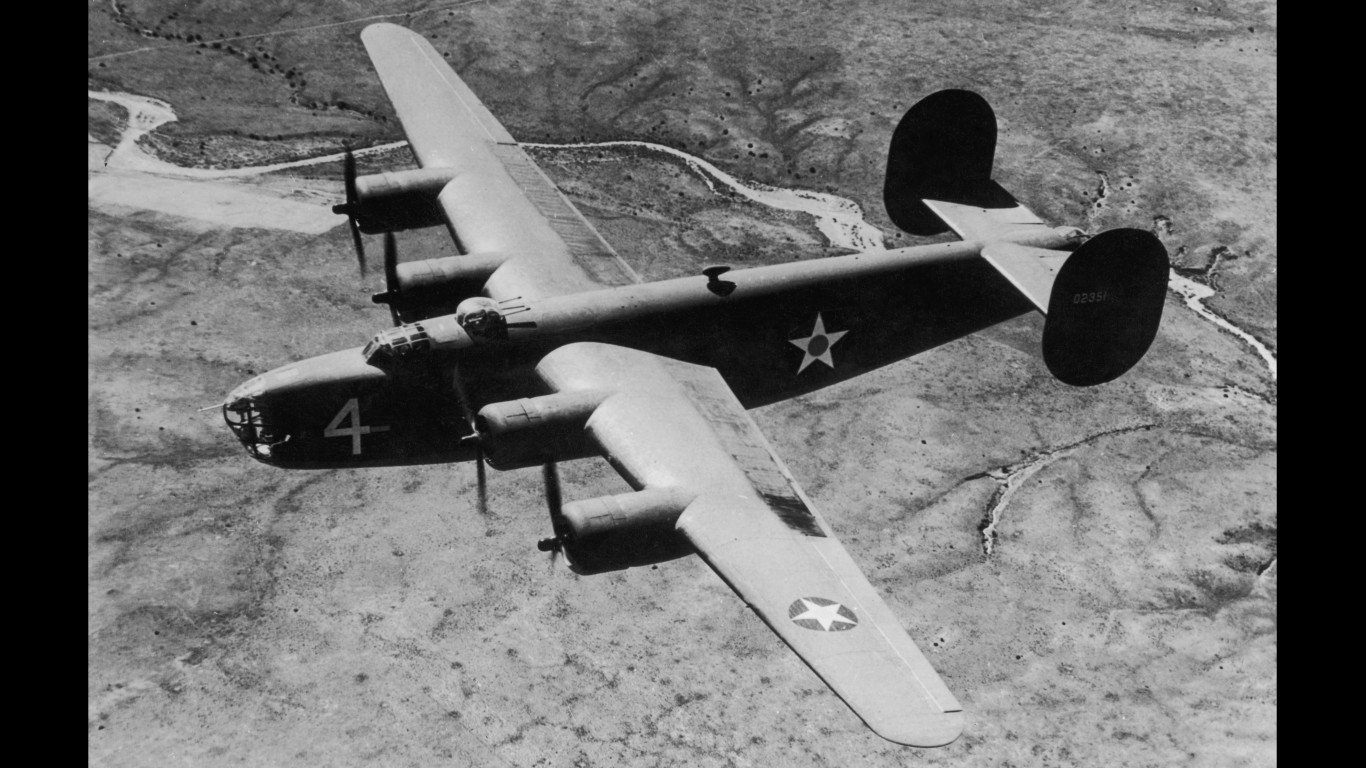
The Consolidated B-24 Liberator entered service in 1941 with a production run of 18,482 and a 10-person crew. It played a role in ground attacks, special missions, transport, surveillance, and reconnaissance, with a top speed of 290 mph.
30. Consolidated PB4Y-2 Privateer

The Consolidated PB4Y-2 Privateer entered service in 1943 with a production run of 739 and an 11-person crew. It played a role in ground attacks, special missions, maritime warfare, surveillance, and reconnaissance, with a top speed of 300 mph.
29. Martin Baltimore
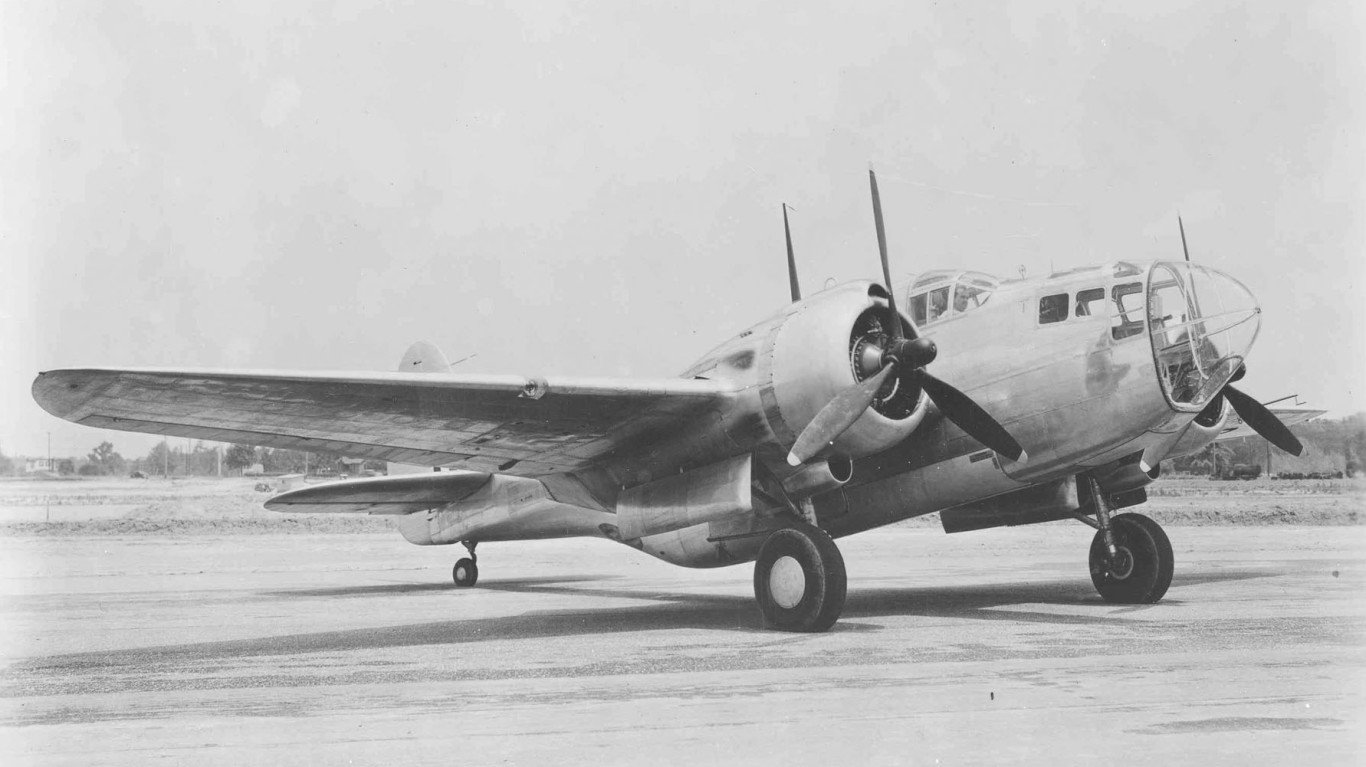
The Martin Baltimore entered service in 1941 with a production run of 1,575 and a four-person crew. It played a role in ground attacks, with a top speed of 302 mph.
28. Consolidated Vultee TBY Sea Wolf
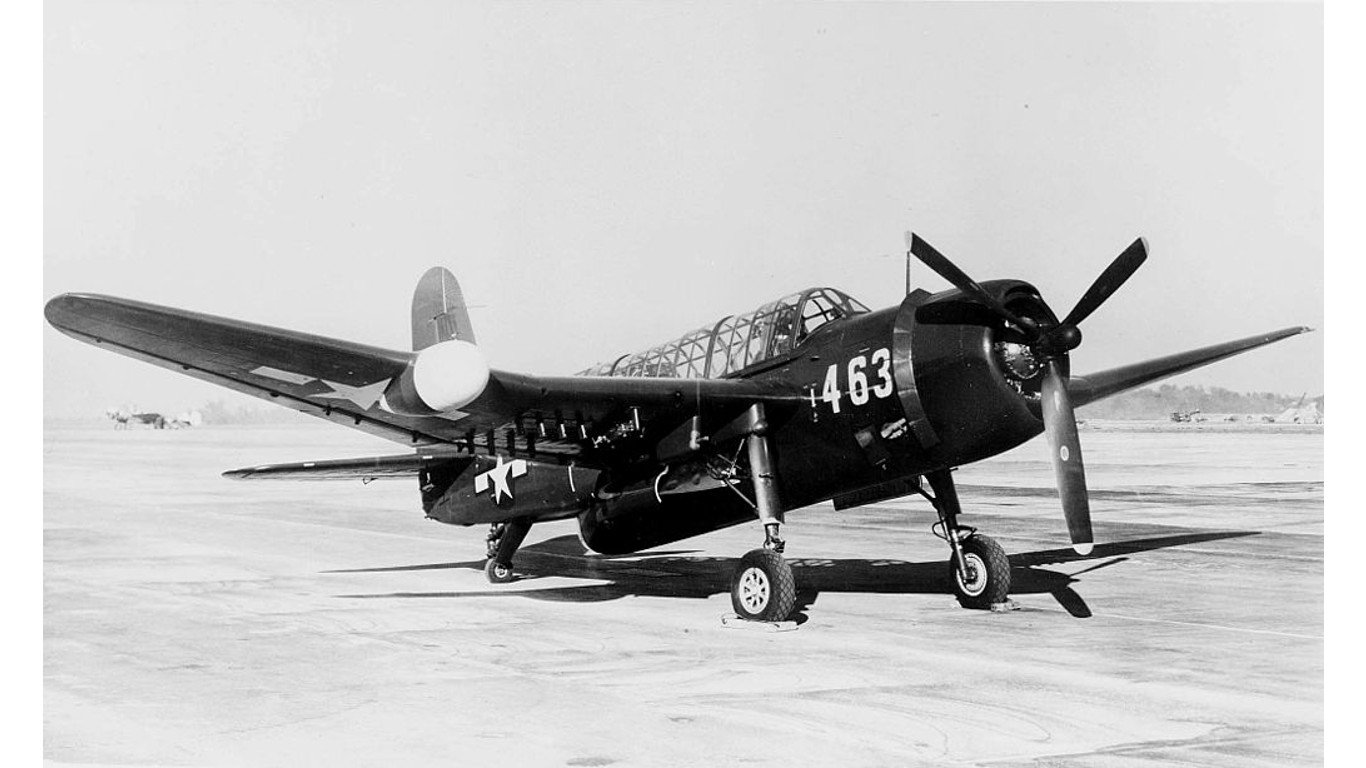
The Consolidated Vultee TBY Sea Wolf entered service in 1944 with a production run of 180 and a three-person crew. It played a role in ground attacks and maritime warfare, with a top speed of 306 mph.
27. Seversky P-35
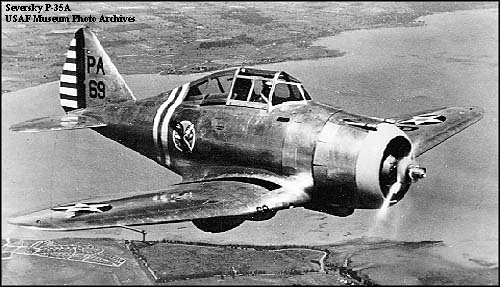
The Seversky P-35 entered service in 1937 with a production run of 196 and a single-person crew. It played a role in air-to-air combat fighting, interception, ground attacks, and training, with a top speed of 308 mph.
26. Curtiss SC Seahawk
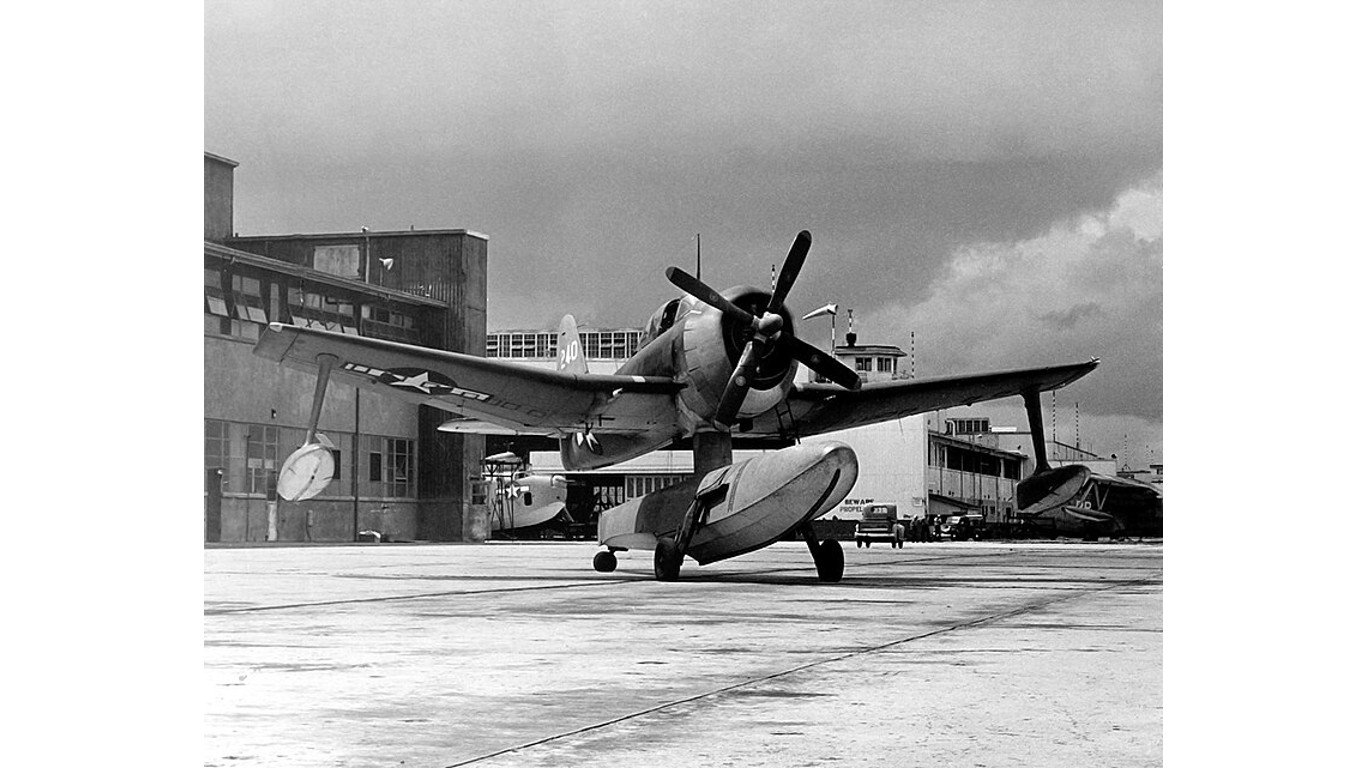
The Curtiss SC Seahawk entered service in 1944 with a production run of 577 and a single-person crew. It played a role in special missions, maritime, surveillance, and reconnaissance, with a top speed of 313 mph.
25. Martin Maryland
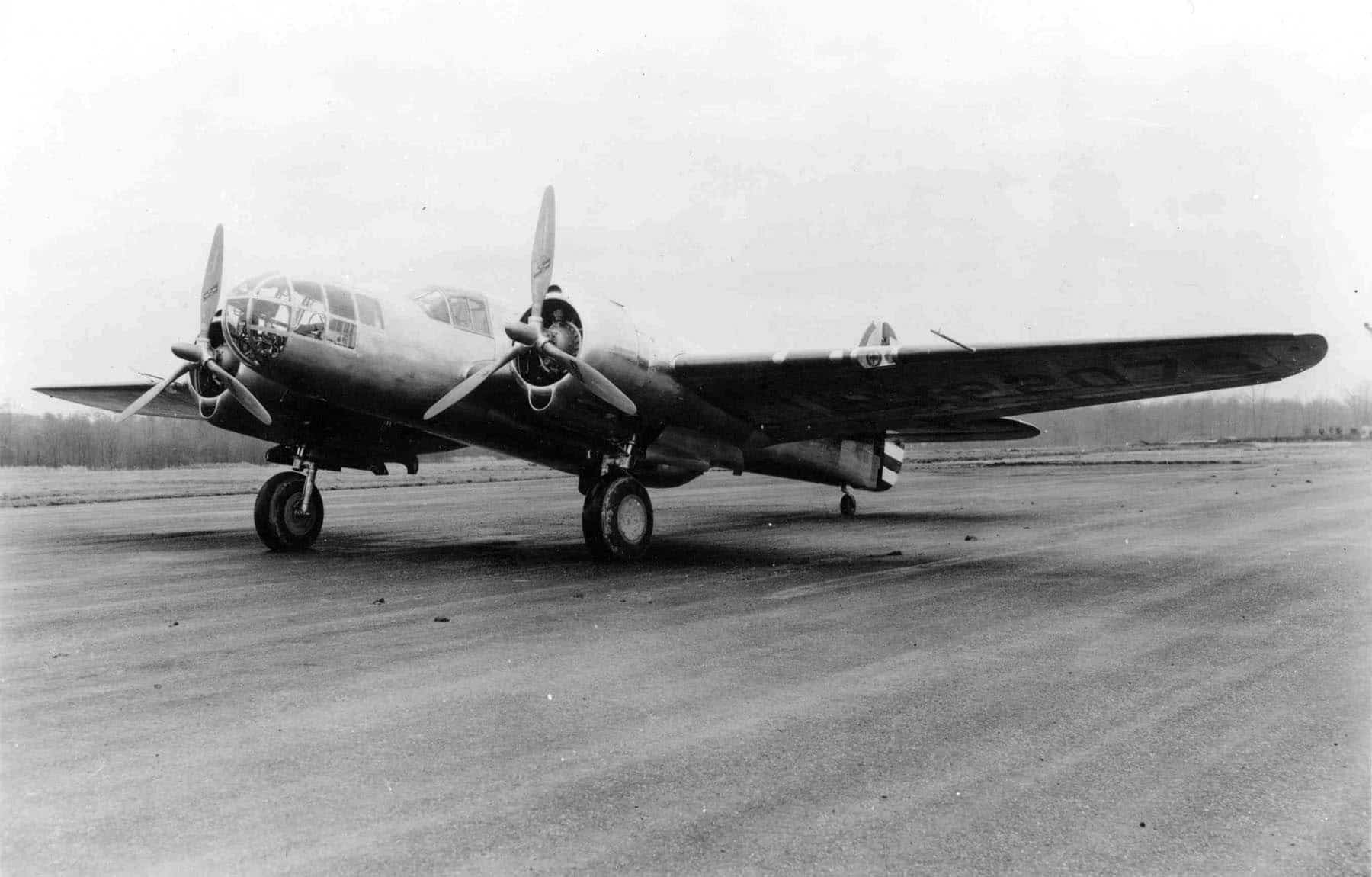
The Martin Maryland entered service in 1940 with a production run of 450 and a three-person crew. It played a role in ground attacks, surveillance, and reconnaissance, with a top speed of 316 mph.
24. Brewster F2A (Buffalo)
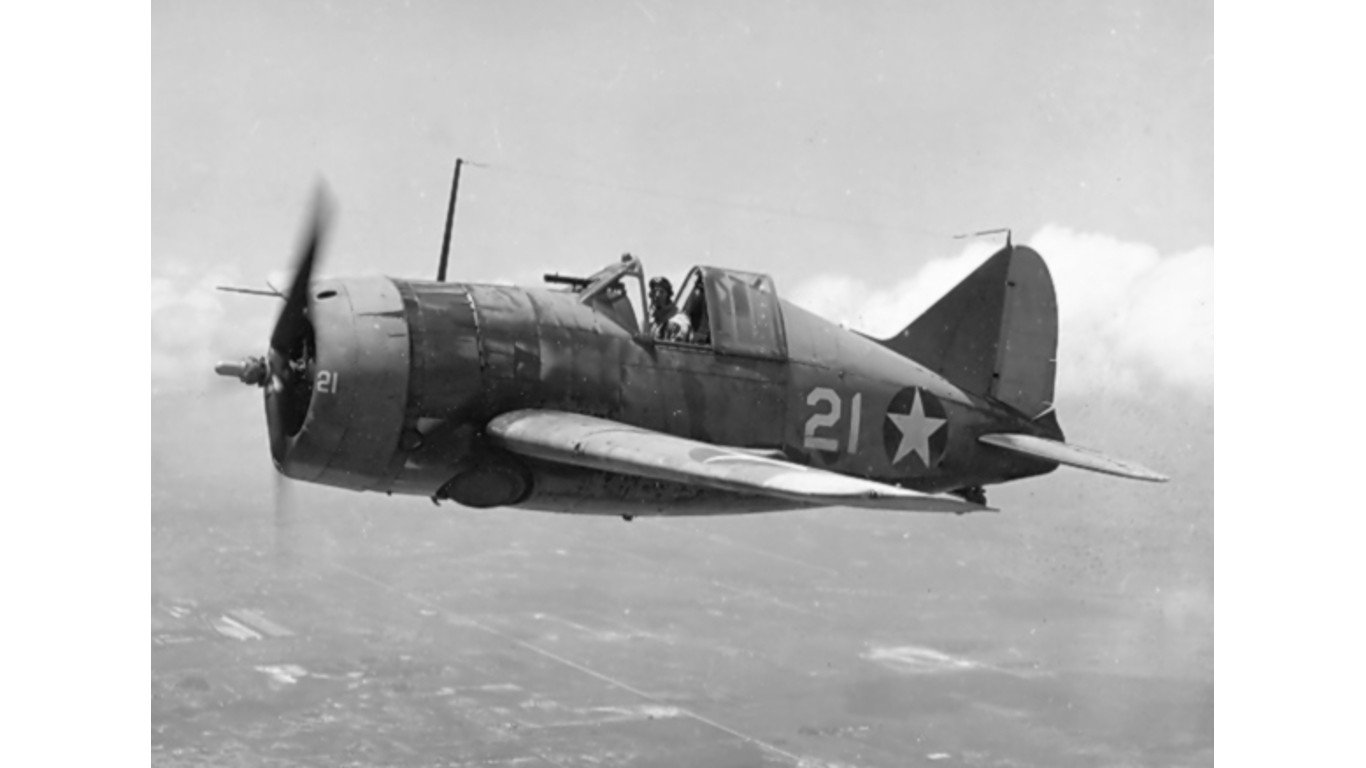
The Brewster F2A (Buffalo) entered service in 1939 with a production run of 509 and a single-person crew. It played a role in air-to-air combat fighting, and maritime warfare, with a top speed of 321 mph.
23. Lockheed Ventura / Harpoon
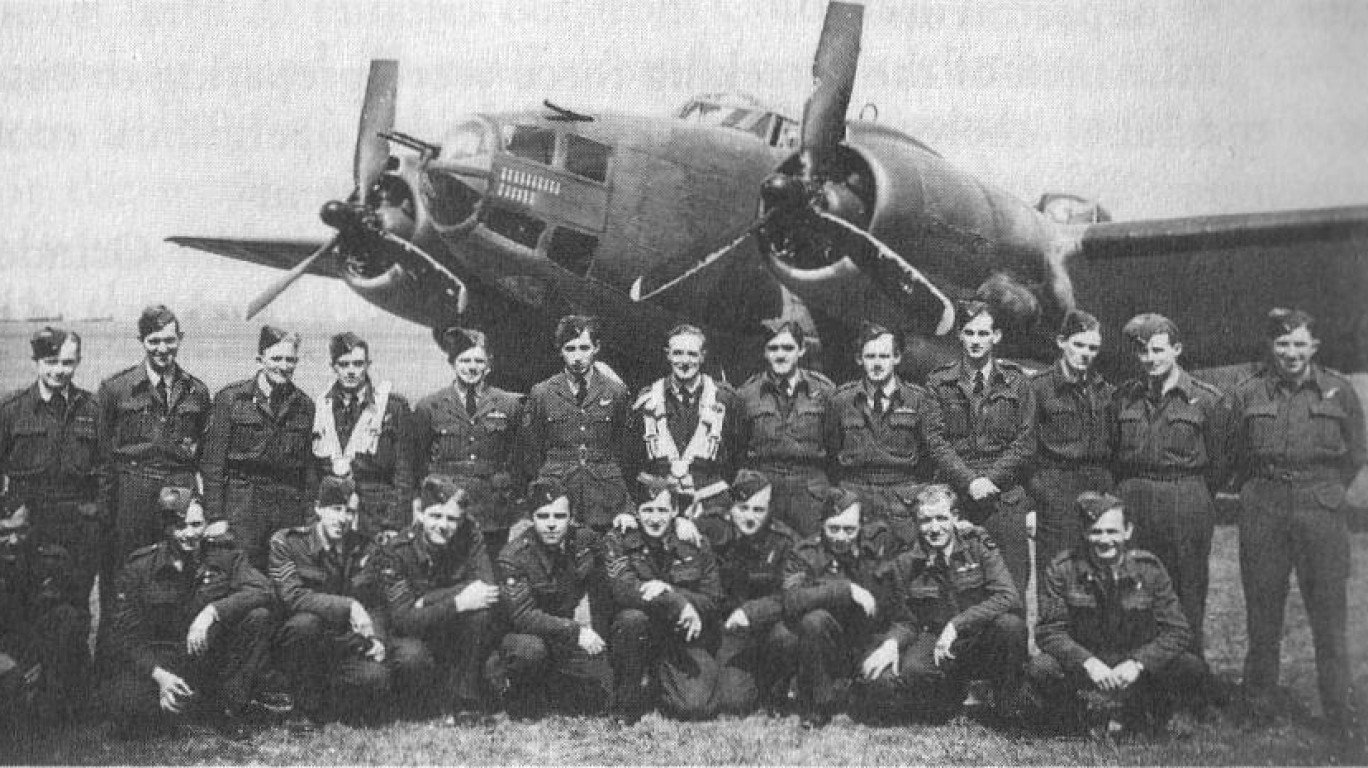
The Lockheed Ventura / Harpoon entered service in 1942 with a production run of 3,028 and a six-person crew. It played a role in ground attacks, special missions, surveillance, reconnaissance, and training, with a top speed of 322 mph.
22. Curtiss P-36 Hawk (Hawk 75/Mohawk)
The Curtiss P-36 Hawk (Hawk 75/Mohawk) entered service in 1938 with a production run of 1,115 and a single-person crew. It played a role in air-t0-air combat fighting, with a top speed of 322 mph.
21. Grumman F4F Wildcat
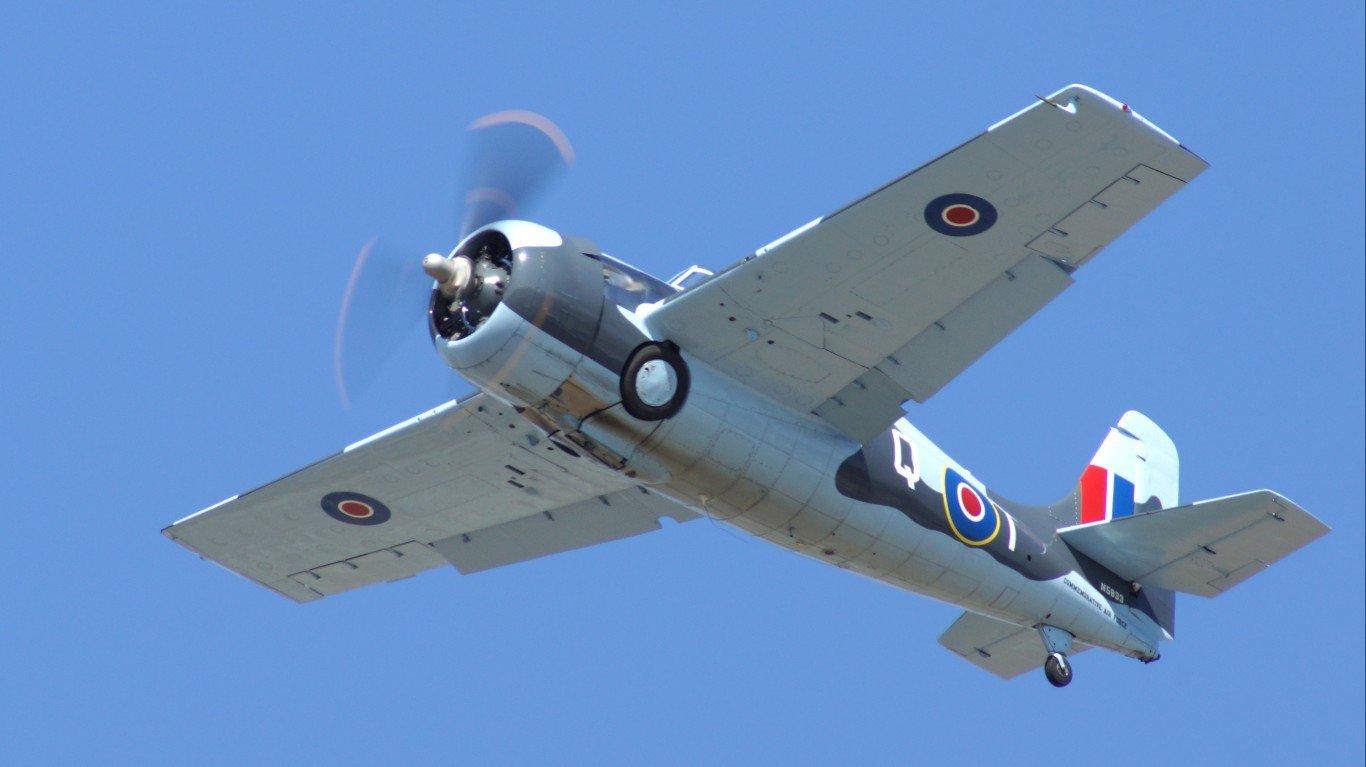
The Grumman F4F Wildcat entered service in 1940 with a production run of 7,722 and a single-person crew. It played a role in air-t0-air combat fighting, ground attacks, and maritime warfare, with a top speed of 332 mph.
20. Douglas P-70 Nighthawk
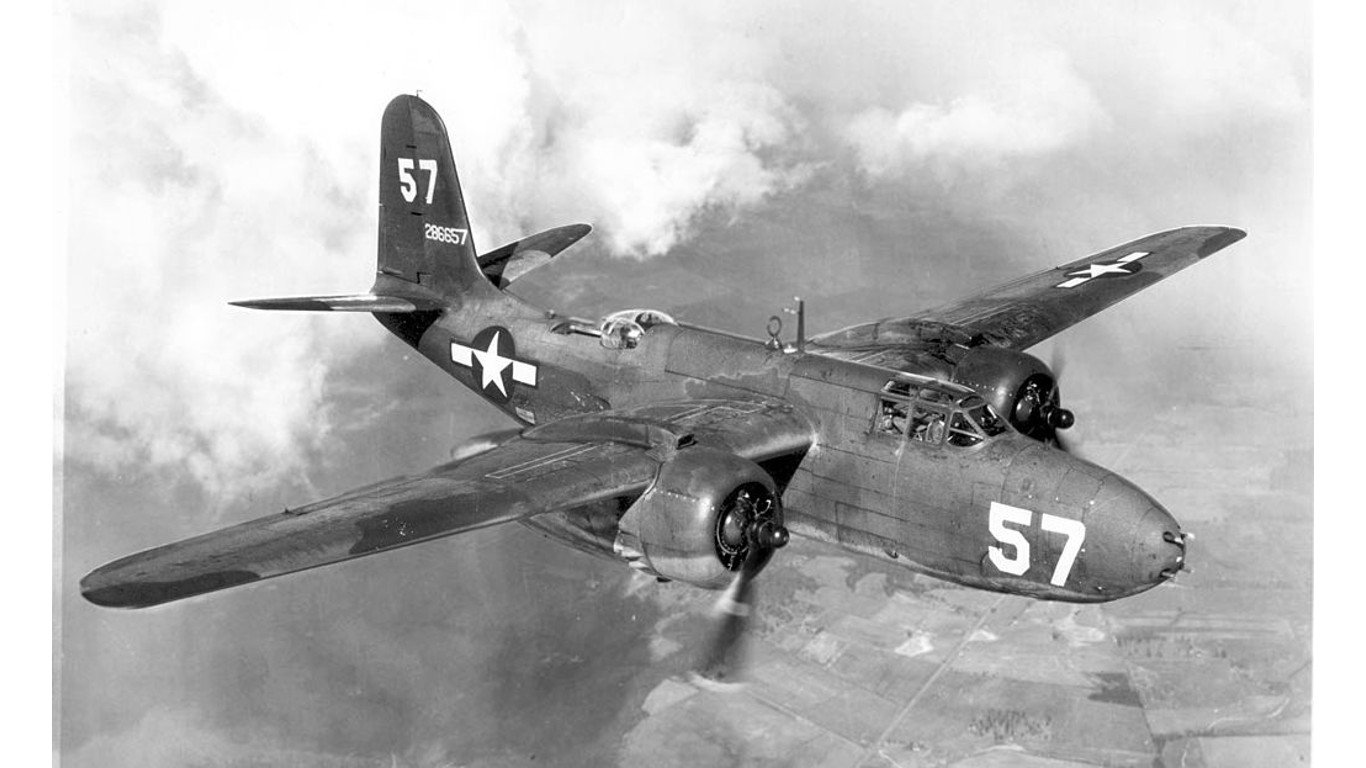
The Douglas P-70 Nighthawk entered service in 1942 with a production run of 163 and a three-person crew. It played a role in air-t0-air combat fighting, interception, and training, with a top speed of 339 mph.
19. Douglas A-20 Havoc / Boston
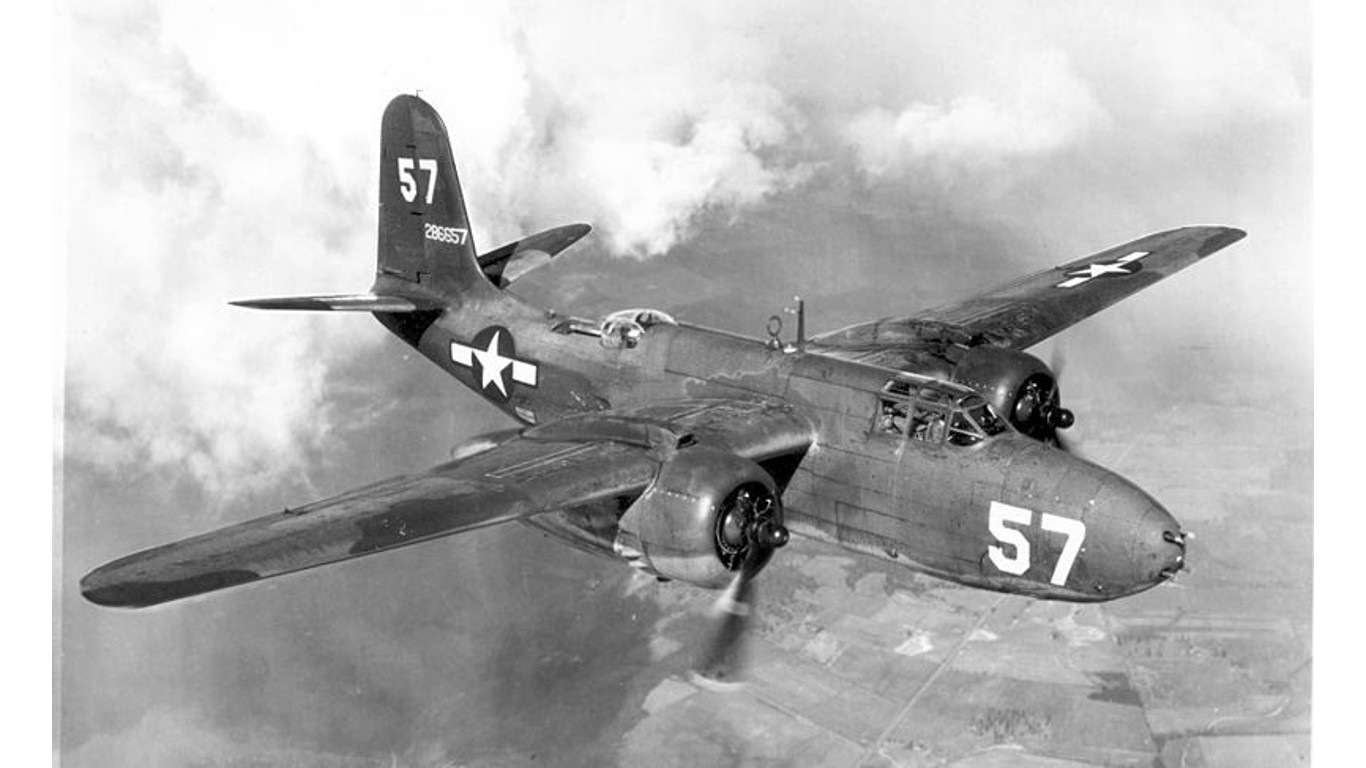
The Douglas A-20 Havoc / Boston entered service in 1941 with a production run of 7,478 and a three-person crew. It played a role in air-t0-air combat fighting, ground attacks, surveillance, and reconnaissance, with a top speed of 339 mph.
18. Lockheed C-69 Constellation (Model L-049)

The Lockheed C-69 Constellation (Model L-049) entered service in 1945 with a production run of 856 and a four-person crew. It played a role in transport, with a top speed of 346 mph.
17. Curtiss P-40 Tomahawk
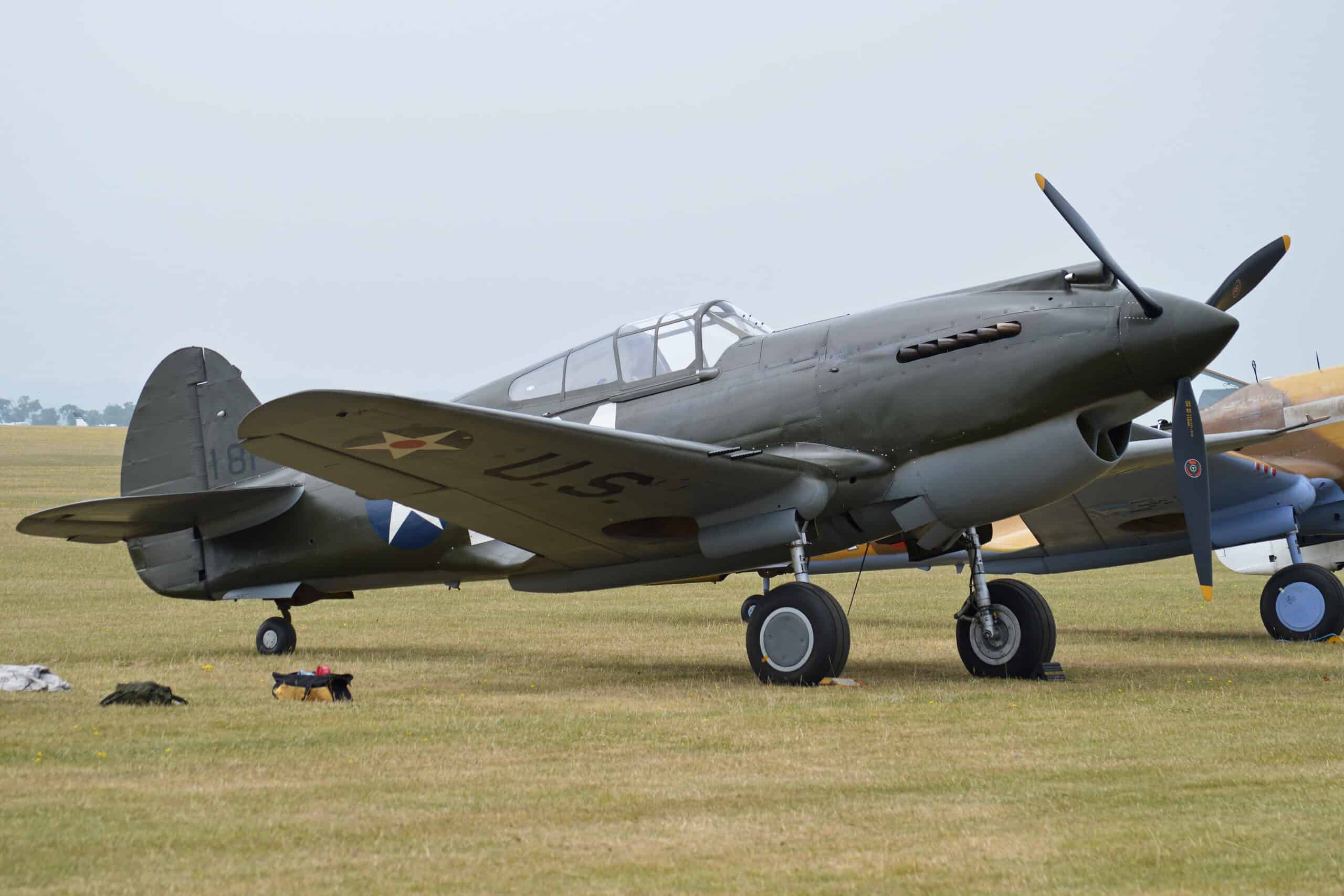
The Curtiss P-40 Tomahawk entered service in 1941 with a production run of 1,180 and a single-person crew. It played a role in air-to-air combat fighting and ground attacks, with a top speed of 351 mph.
16. Douglas A-26 / B-26 Invader

The Douglas A-26 / B-26 Invader entered service in 1944 with a production run of 2,452 and a three-person crew. It played a role in ground attacks, close-air support, surveillance, reconnaissance, and training, with a top speed of 355 mph.
15. Republic P-43 Lancer
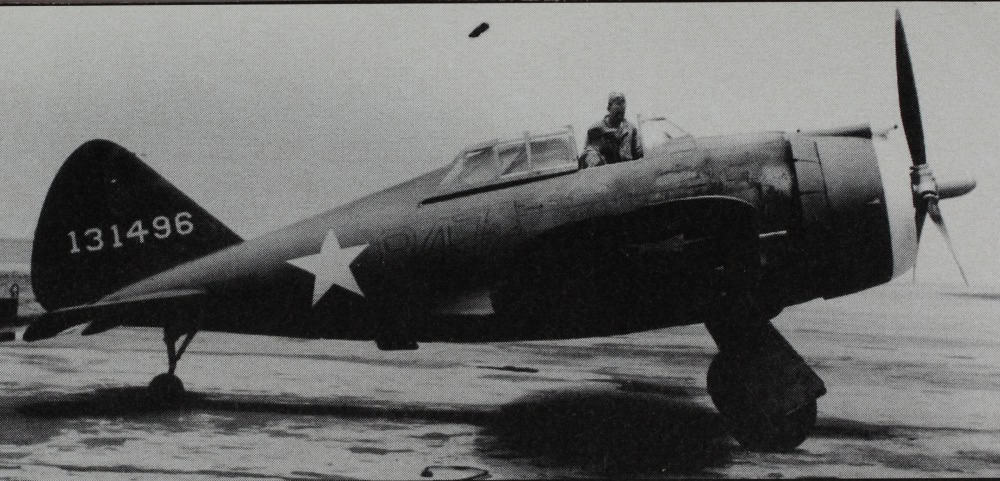
The Republic P-43 Lancer entered service in 1941 with a production run of 272 and a single-person crew. It played a role in air-to-air combat fighting, ground attacks, surveillance, reconnaissance, and training, with a top speed of 357 mph.
14. North American A-36 Mustang
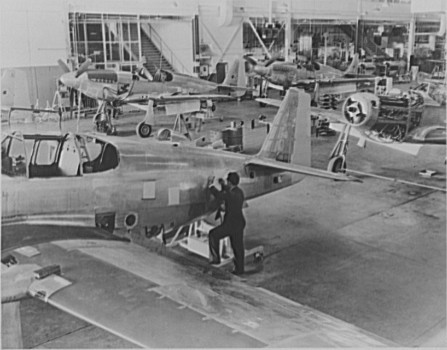
The North American A-36 Mustang entered service in 1943 with a production run of 500 and a single-person crew. It played a role in air-to-air combat fighting, ground attacks, and close air support, with a top speed of 365 mph.
13. Northrop P-61 / F-61 Black Widow
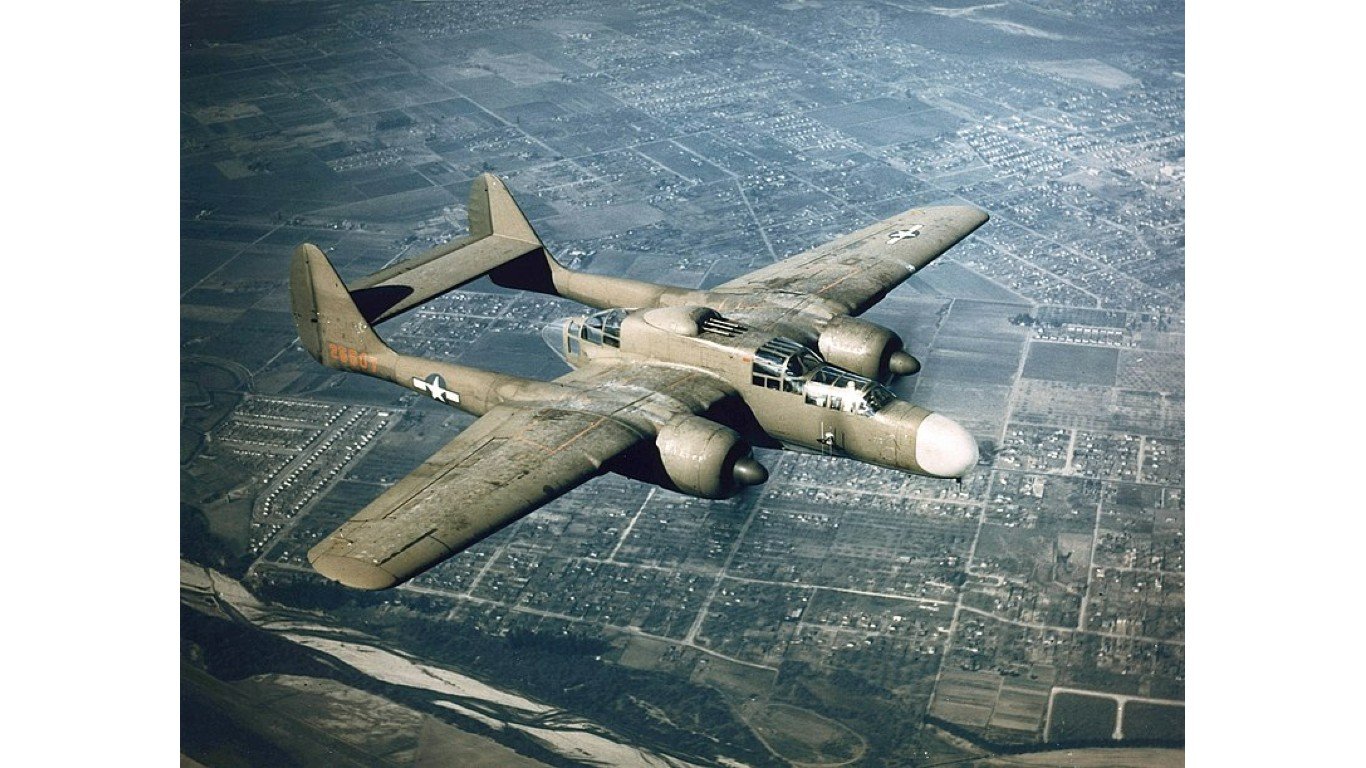
The Northrop P-61 / F-61 Black Widow entered service in 1943 with a production run of 742 and a three-person crew. It played a role in air-to-air combat fighting, surveillance, and reconnaissance, with a top speed of 366 mph.
12. Curtiss P-40 Warhawk
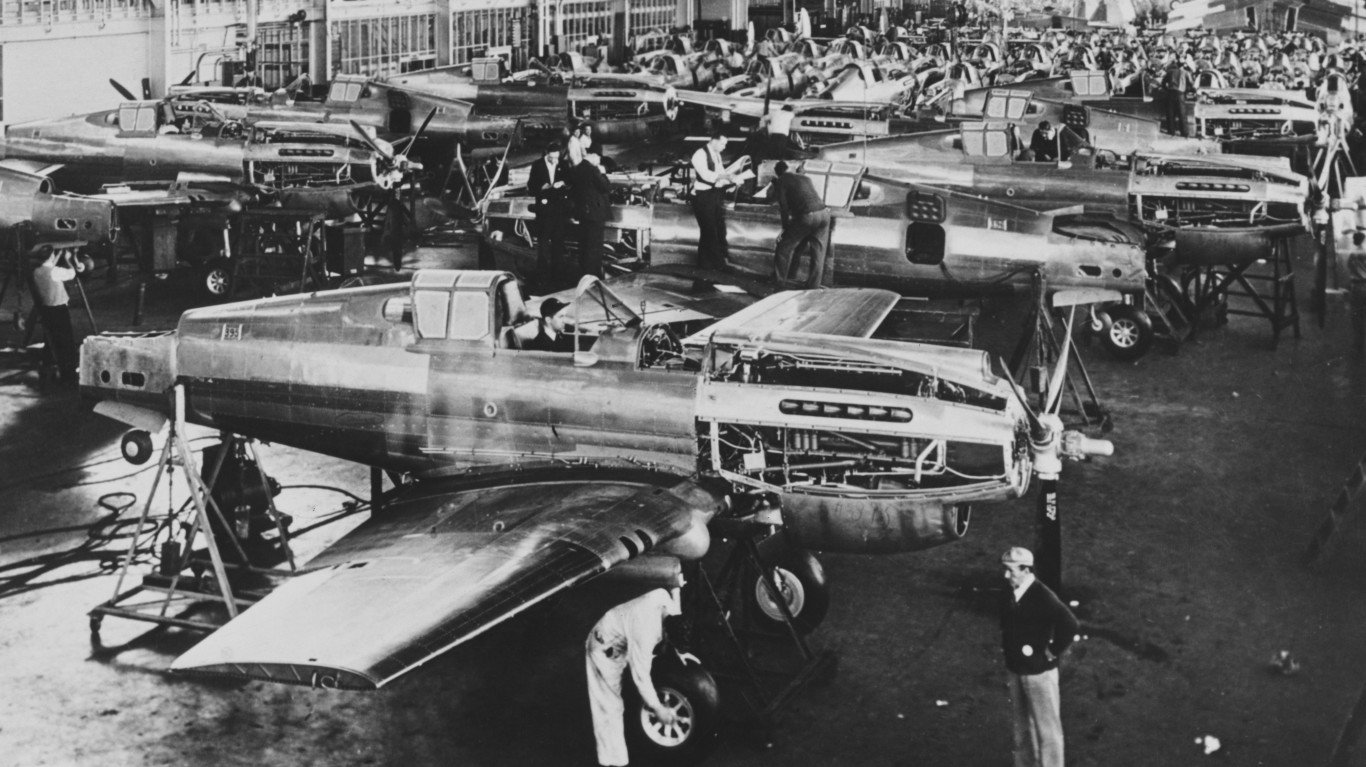
The Curtiss P-40 Warhawk entered service in 1941 with a production run of 16,800 and a single-person crew. It played a role in air-to-air combat fighting, surveillance, and reconnaissance, with a top speed of 378 mph.
11. Grumman F6F Hellcat

The Grumman F6F Hellcat entered service in 1943 with a production run of 12,272 and a single-person crew. It played a role in air-to-air combat fighting, interception, ground attacks, and close air support, with a top speed of 380 mph.
10. Martin AM Mauler
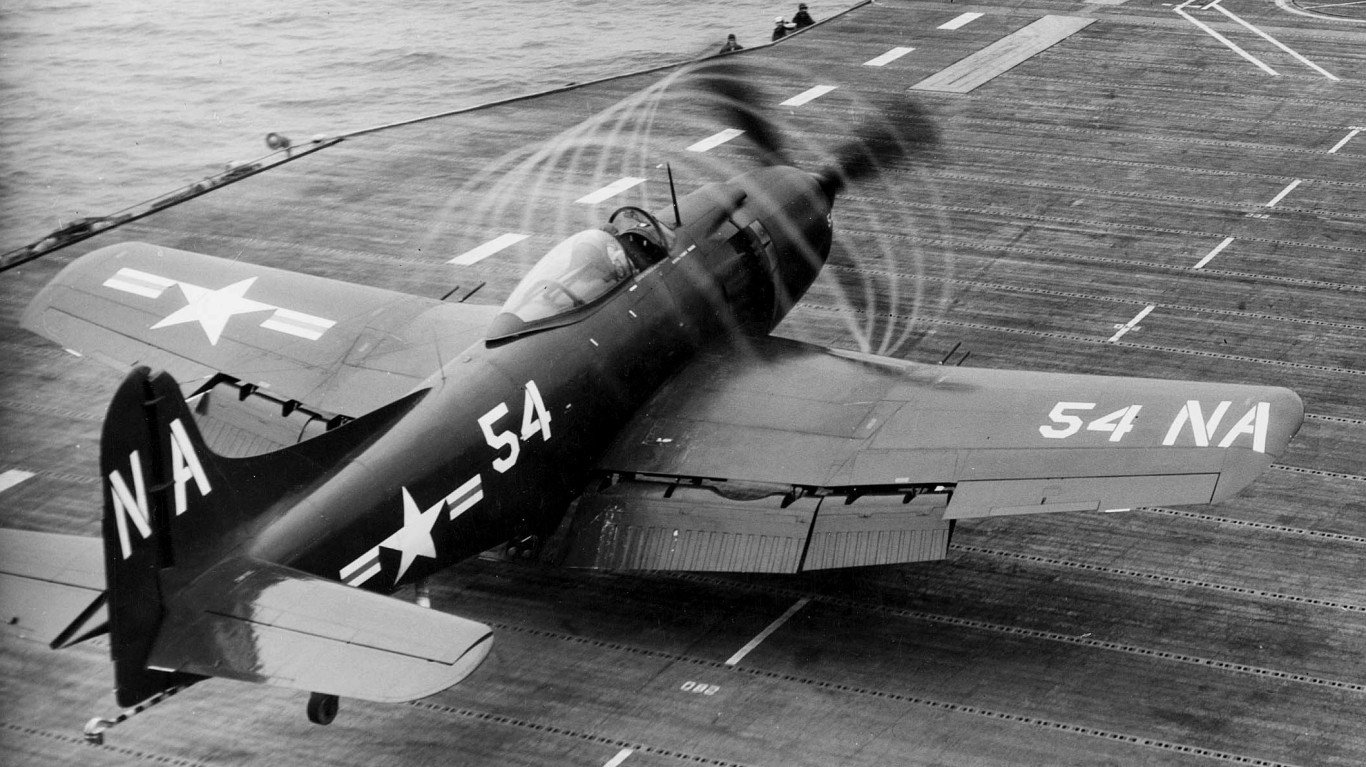
The Martin AM Mauler entered service in 1944 with a production run of 151 and a single-person crew. It played a role in close air support and maritime warfare, with a top speed of 384 mph.
9. Bell P-39 Airacobra
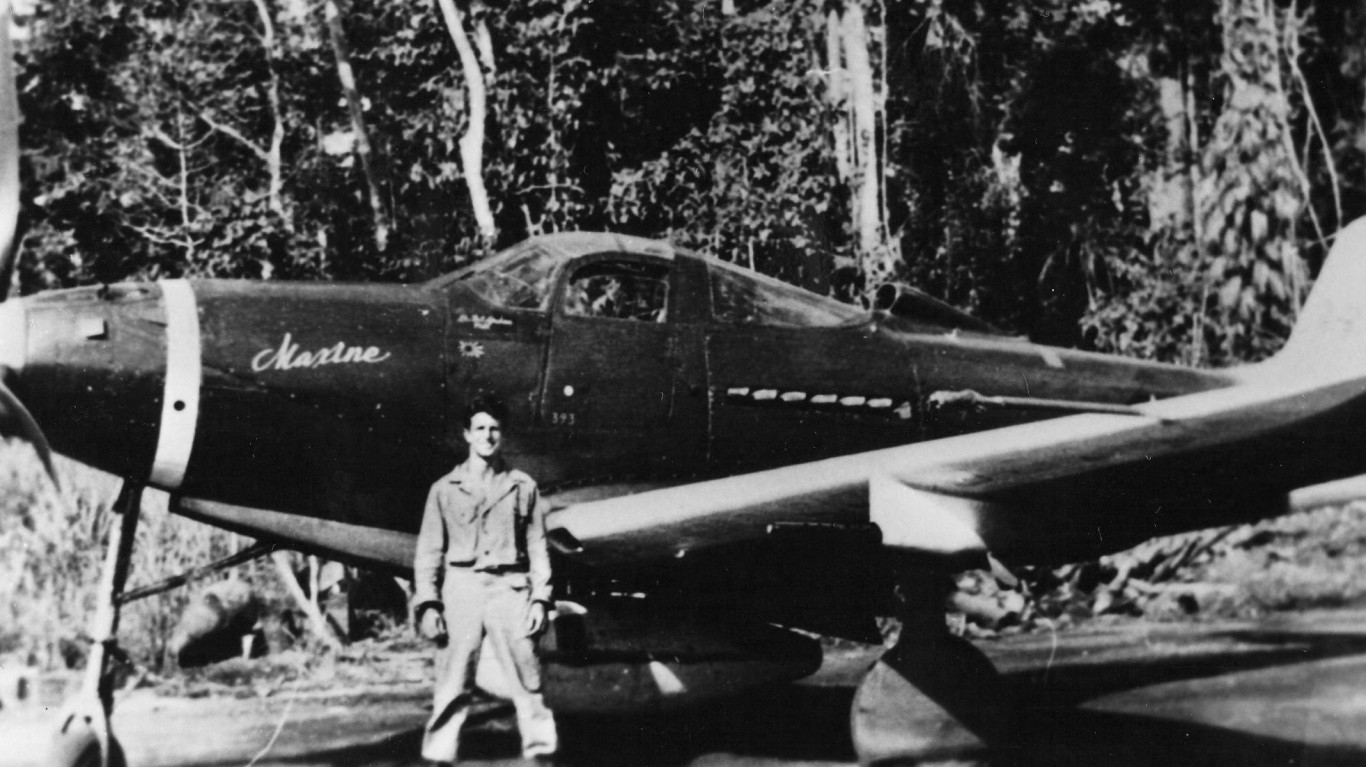
The Bell P-39 Airacobra entered service in 1941 with a production run of 9,588 and a single-person crew. It played a role in air-to-air combat fighting, interception, ground attacks, and close air support, with a top speed of 386 mph.
8. Bell P-63 Kingcobra
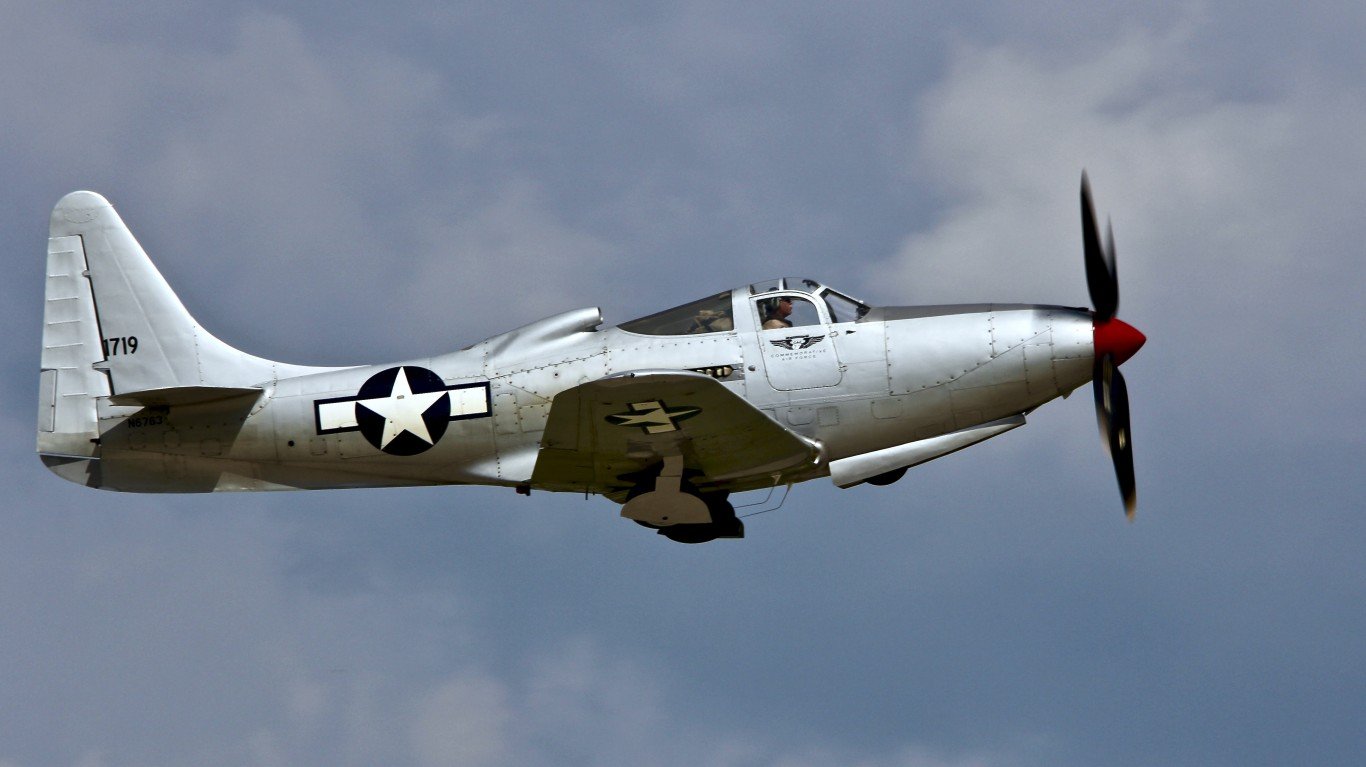
The Bell P-63 Kingcobra entered service in 1943 with a production run of 3,303 and a single-person crew. It played a role in air-to-air combat fighting and close air support, with a top speed of 410 mph.
7. Lockheed P-38 Lightning

The Lockheed P-38 Lightning entered service in 1939 with a production run of 9,923 and a single-person crew. It played a role in air-to-air combat fighting, ground attacks (bombing, strafing), and intelligence-surveillance-reconnaissance, with a top speed of 414 mph.
6. Brewster F3A (F4U-1) Corsair
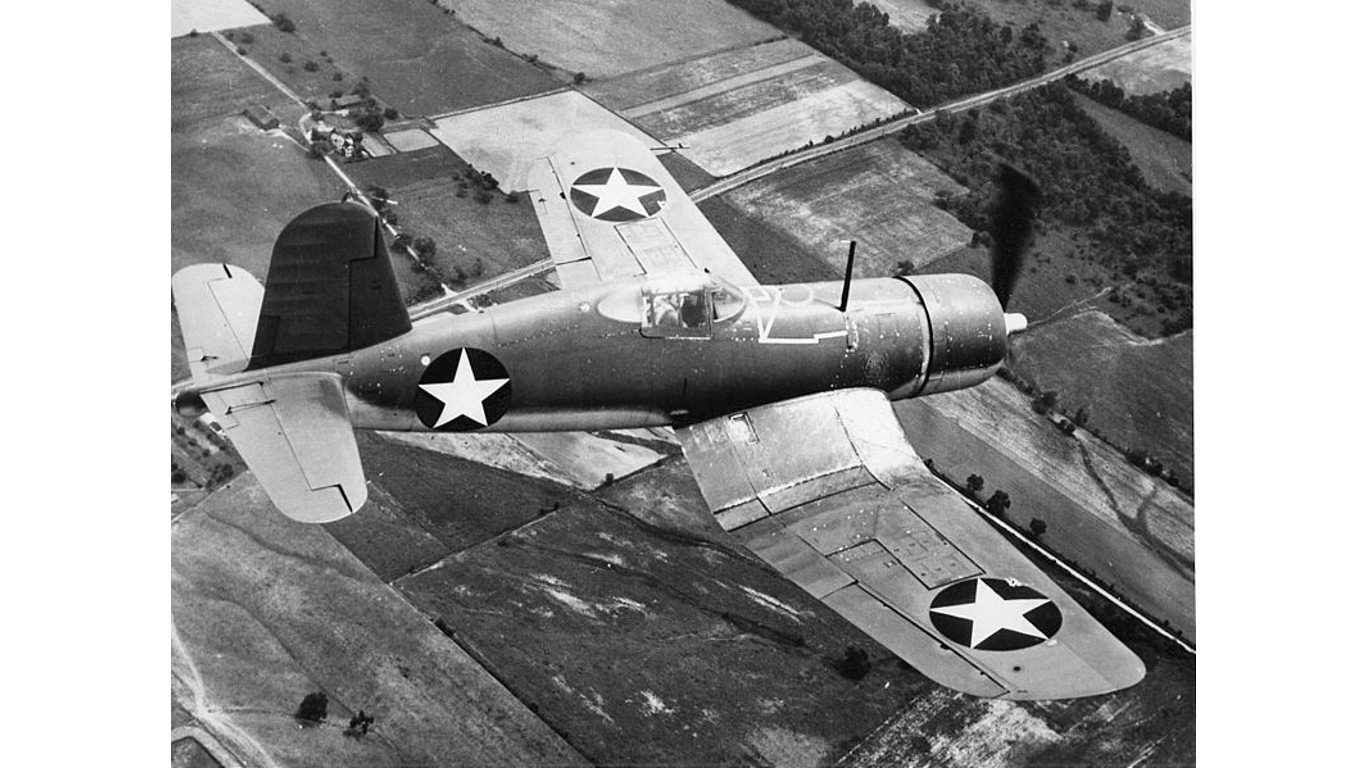
The Brewster F3A (F4U-1) Corsair entered service in 1943 with a production run of 600 and a single-person crew. It played a role in air-to-air combat fighting, interception, ground attacks (bombing, strafing), and intelligence-surveillance-reconnaissance, with a top speed of 416 mph.
5. Grumman F8F Bearcat
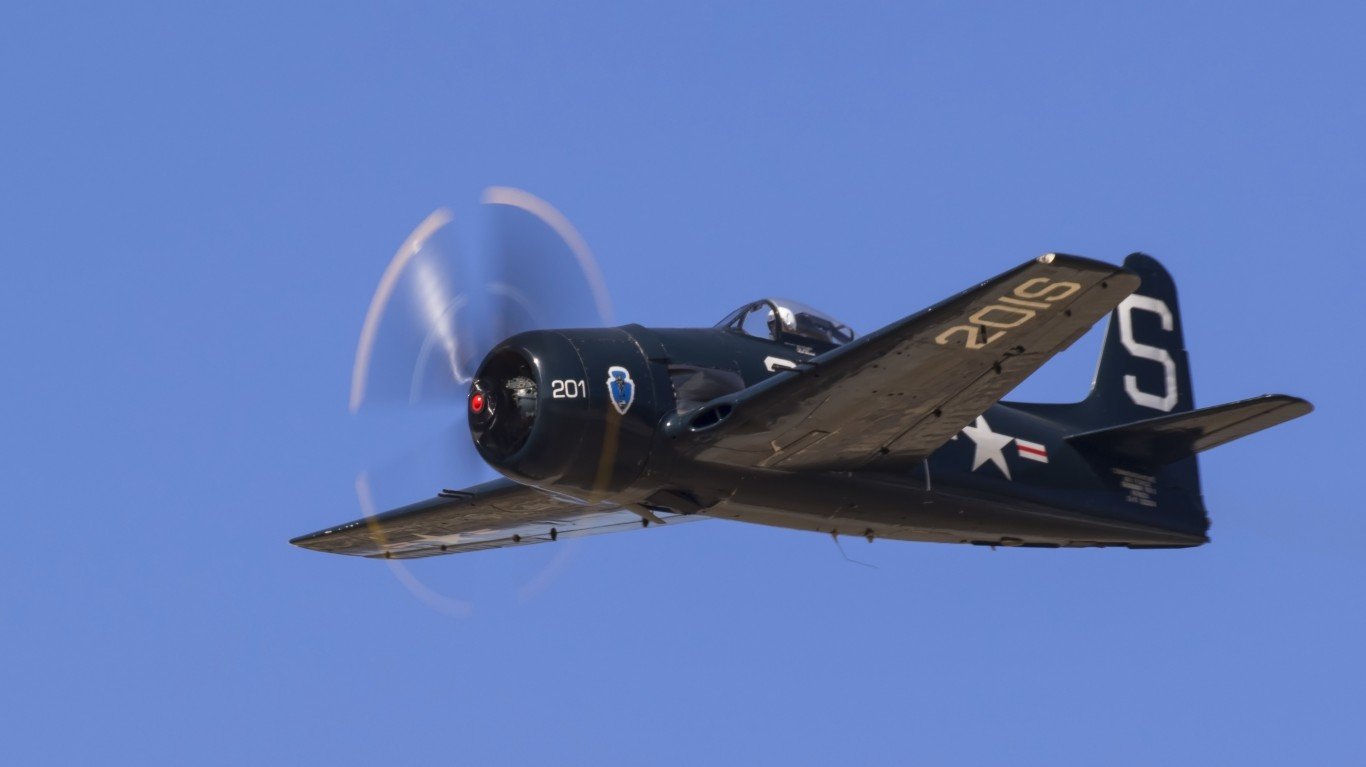
The Grumman F8F Bearcat entered service in 1945 with a production run of 1,266 and a single-person crew. It played a role in air-to-air combat fighting, interception, and maritime warfare with a top speed of 421 mph.
4. Republic P-47 Thunderbolt
The Republic P-47 Thunderbolt entered service in 1942 with a production run of 15,660 and a single-person crew. It played a role in air-to-air combat fighting, interception, ground attacks (bombing, strafing), and close-air support, with a top speed of 433 mph.
3. North American P-51 Mustang
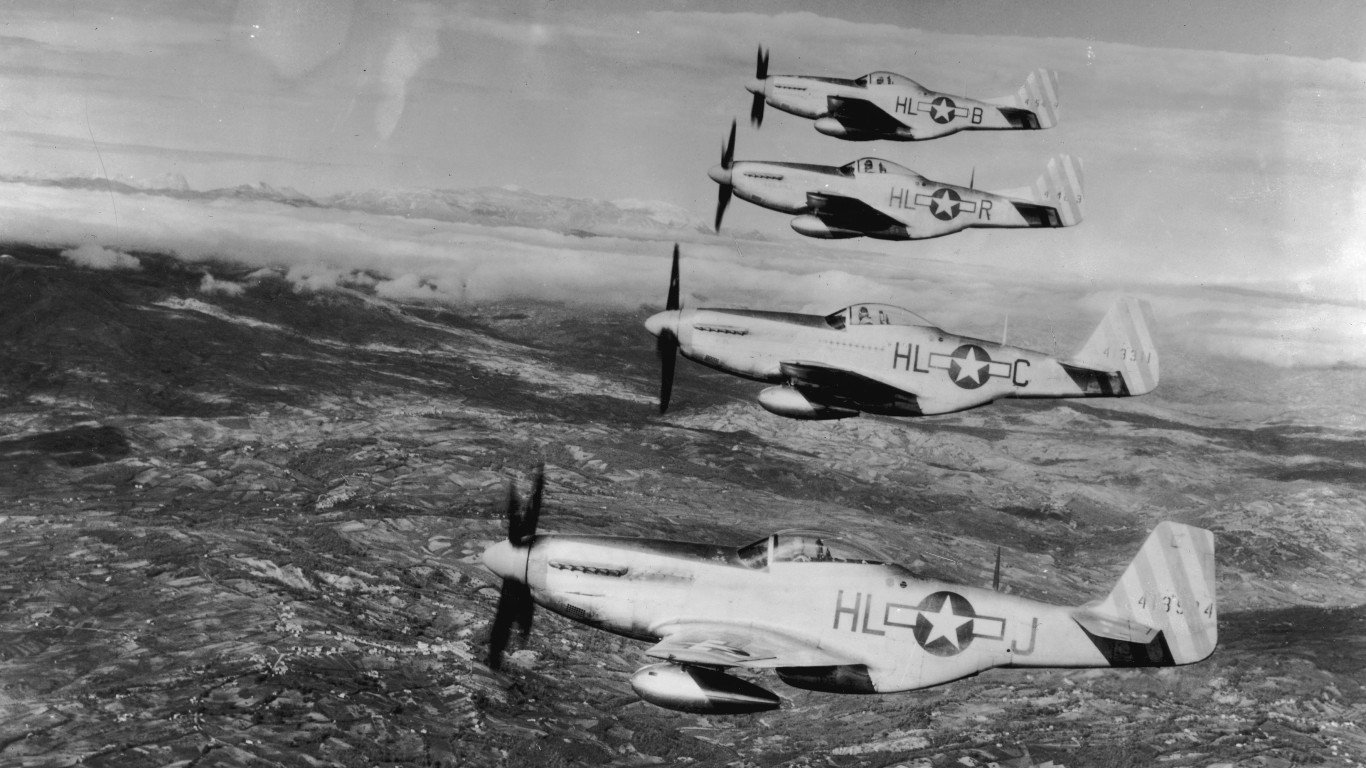
The North American P-51 Mustang entered service in 1942 with a production run of 15,586 and a single-person crew. It played a role in air-to-air combat fighting, interception, close-air support, intelligence-surveillance-reconnaissance, and training, with a top speed of 437 mph.
2. Vought F4U Corsair
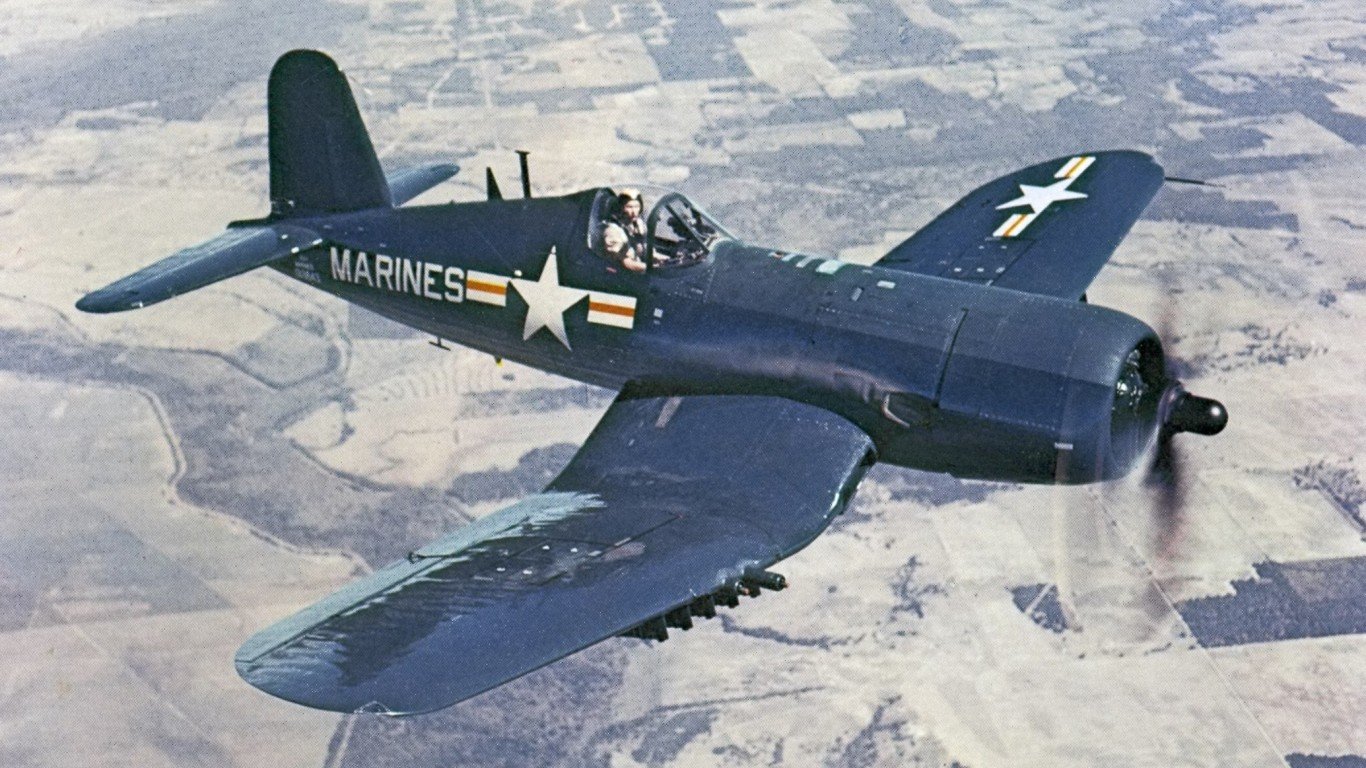
The Vought F4U Corsair entered service in 1942 with a production run of 12,571 and a single-person crew. It played a role in air-to-air combat fighting, interception, ground attacks (bombing, strafing), close-air support, maritime warfare, and intelligence-surveillance-reconnaissance, with a top speed of 446 mph.
1. Lockheed P-80 / F-80 Shooting Star

The Lockheed P-80 / F-80 Shooting Star entered service in 1945 with a production run of 1,715 and a single-person crew. It played a role in air-to-air combat fighting and close-air support, with a top speed of 577 mph.
Buffett Missed These Two…
Warren Buffett loves dividend stocks, and has stuffed Berkshire with some of his favorites.
But he overlooked two dividend legends that continue to print checks on a new level, they’re nowhere in his portfolio.
Unlock the two dividend legends Buffett missed in this new free report.
Thank you for reading! Have some feedback for us?
Contact the 24/7 Wall St. editorial team.

